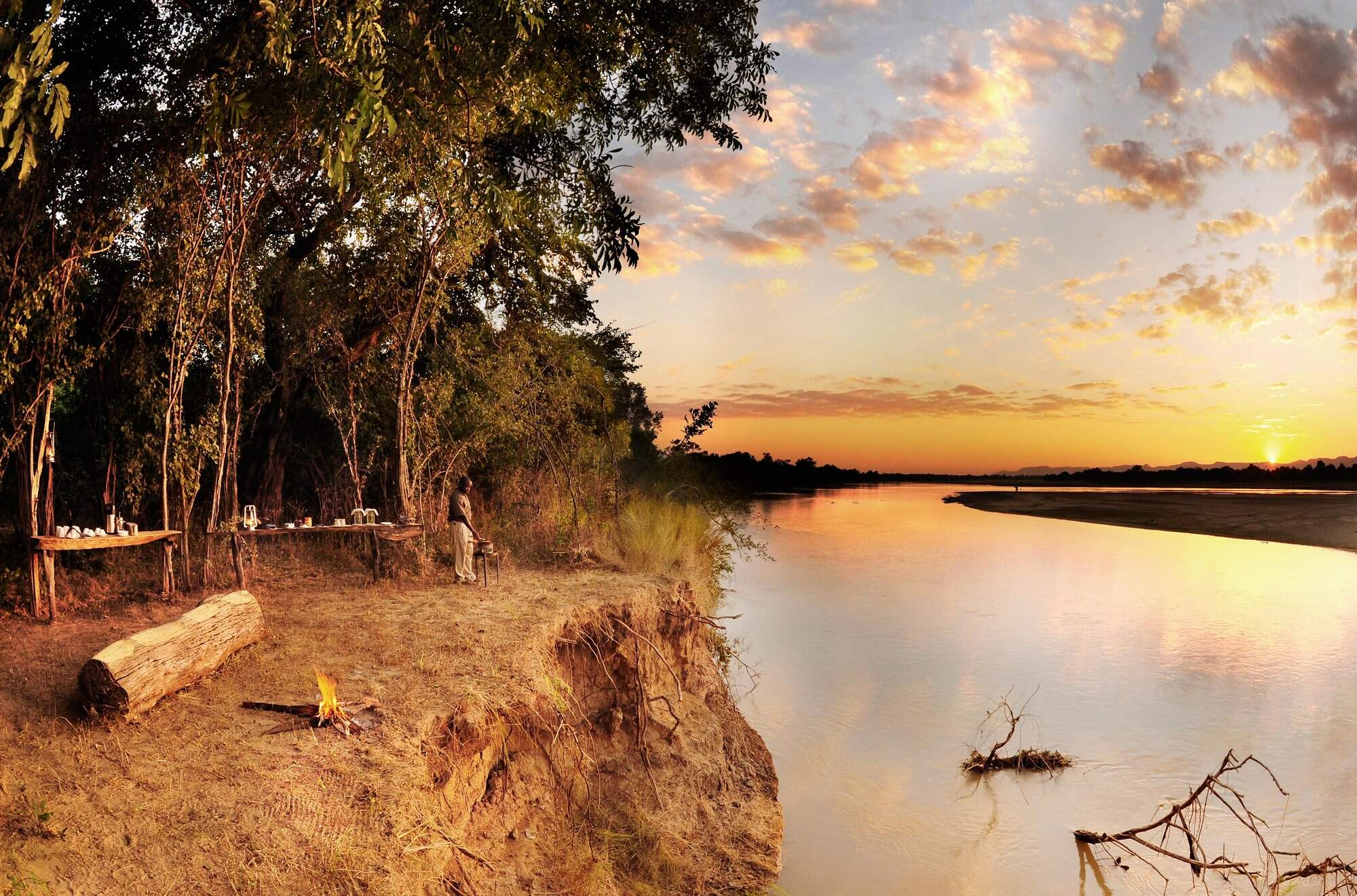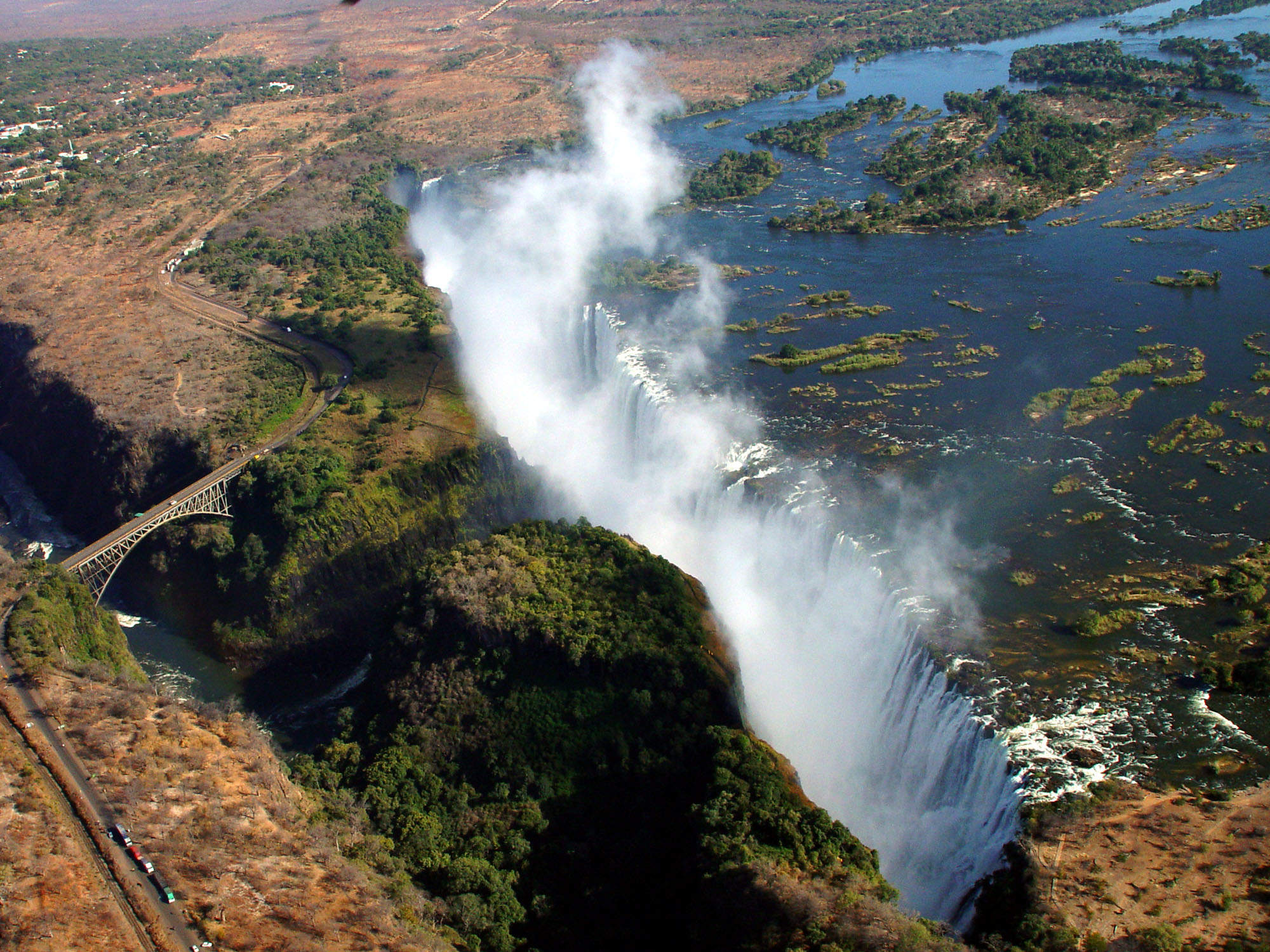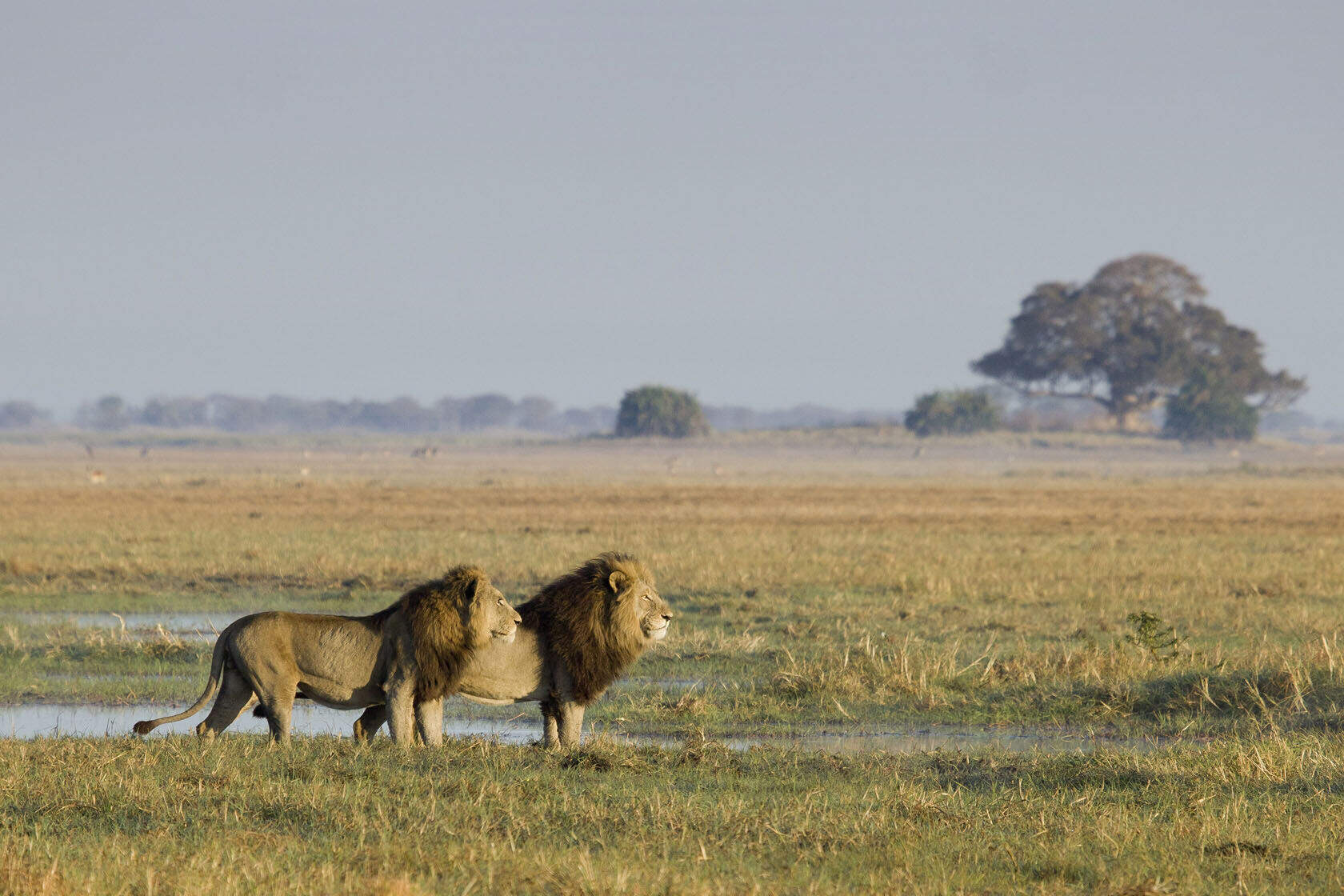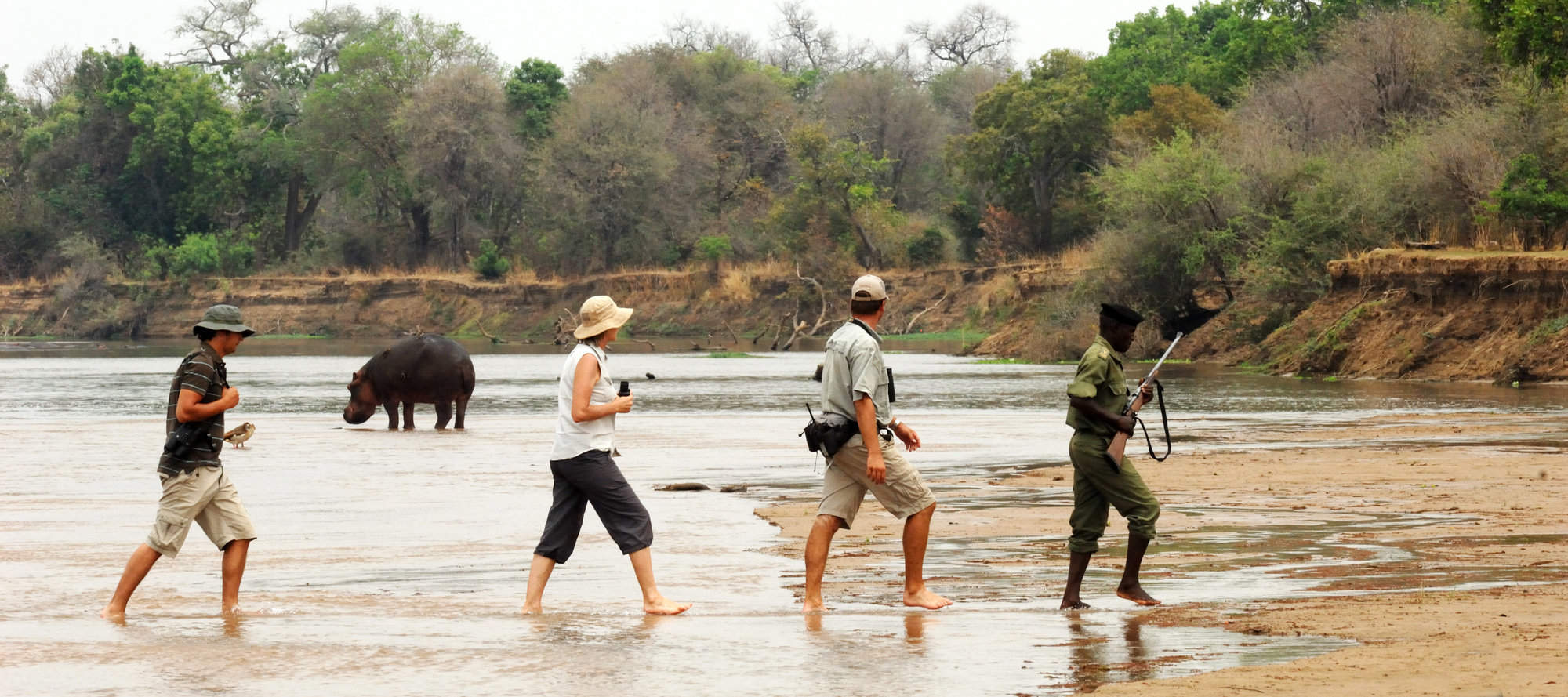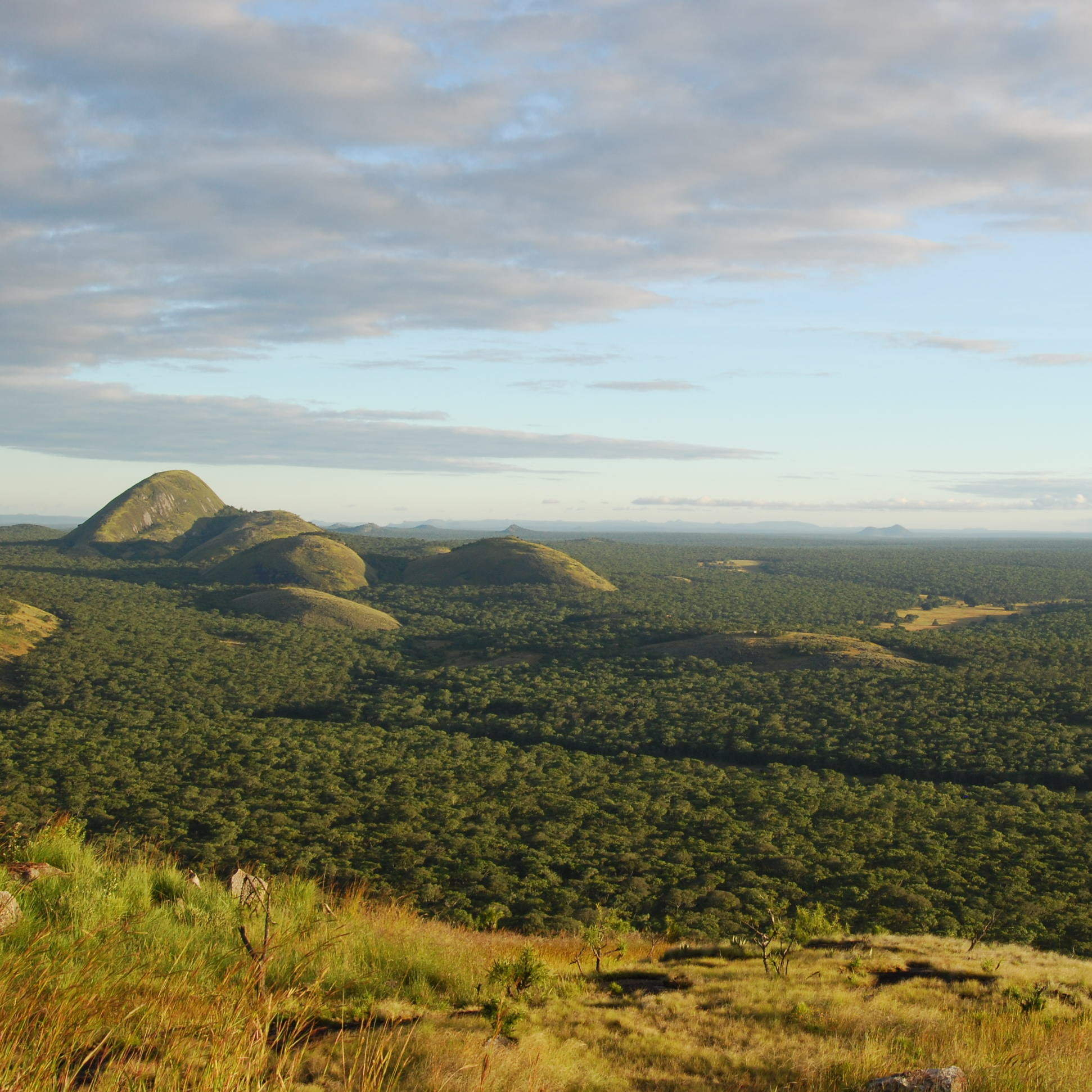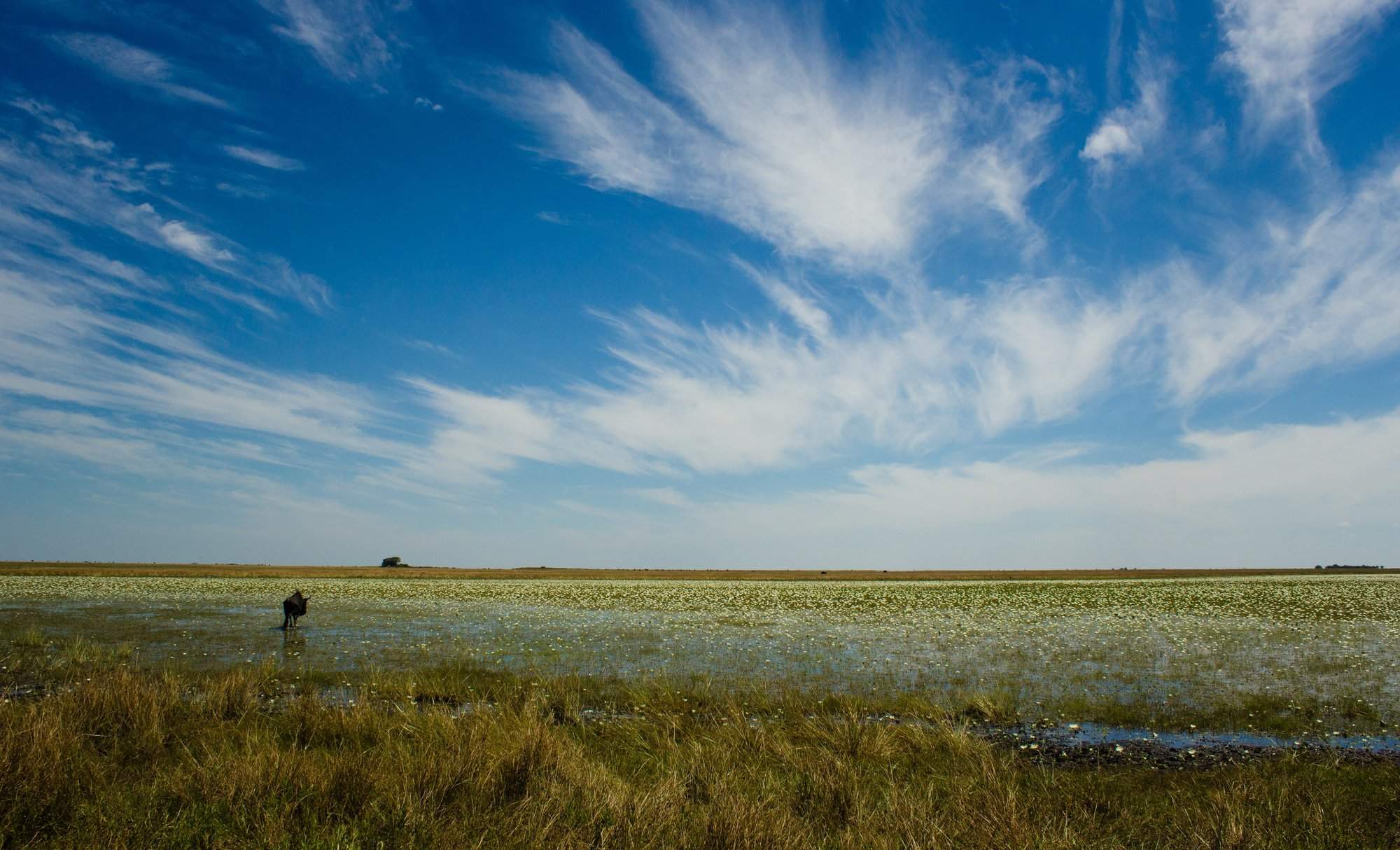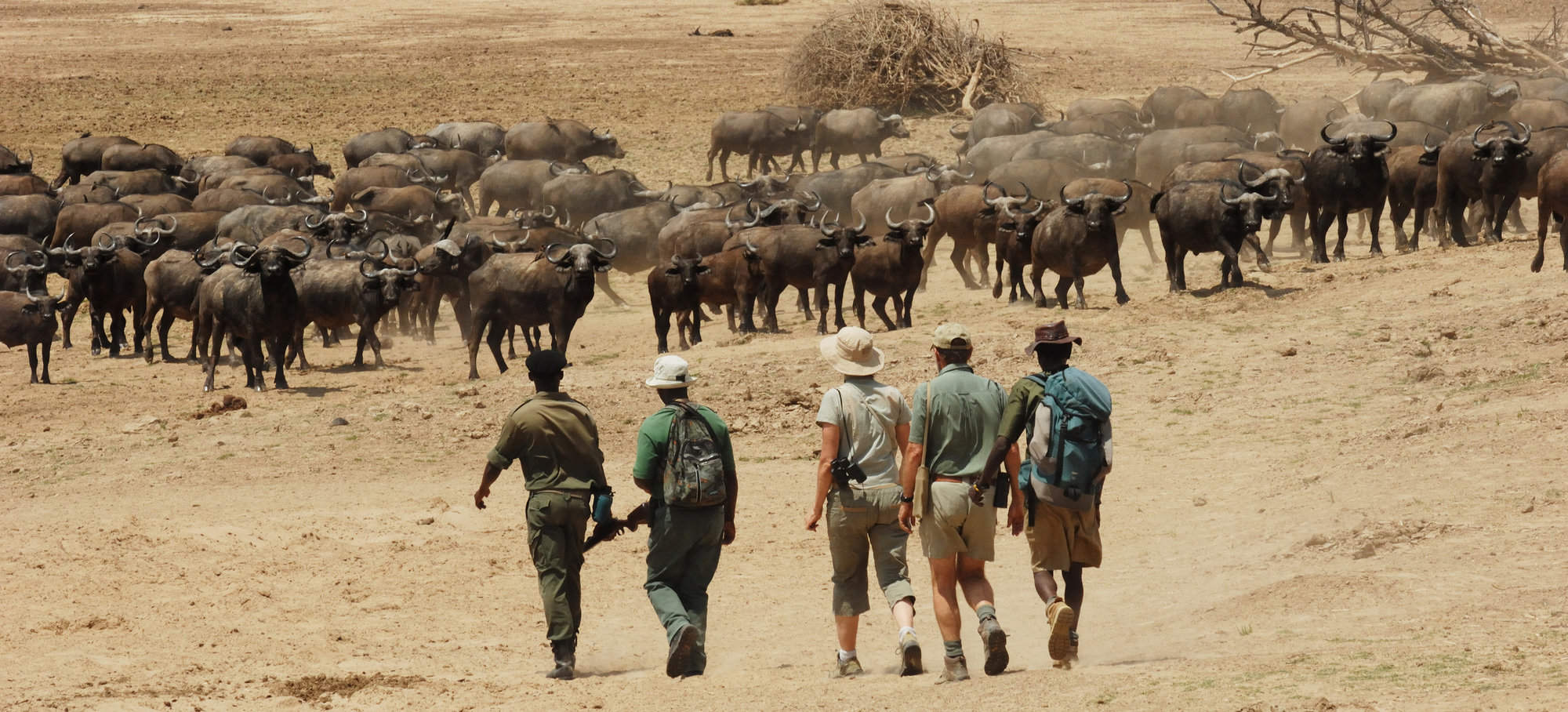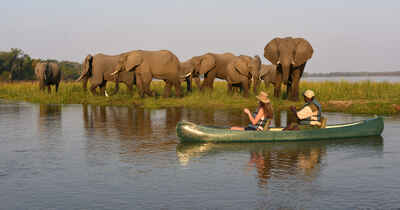
Another perspective ...
Be engrossed in the wilderness
The ancient forests are awe inspiring
Walk with the animals ...
The Zambezi River, Zamiba left - Zimbabwe right
Walk with Africa's finest professional guides
Enjoy excellent guiding at Old Mondoro
Enjpy the luxury at Lolebezi
Walks from Anabezi offer the chance to see the wildlife up close
The resident lion pride keep an eye out for their next meal in front of Royal Zambezi Lodge
Sausage Tree Camp, along with all the other lodges in the park, have prime positions overlooking the permanent Zambezi River
Lower Zambezi National Park
Lower Zambezi National Park
Flowing wide and slow, the mighty Zambezi defines the park, riverine trees hugging its banks, grassland beyond, wildlife all around.
Its life-giving presence comes courtesy of a huge rift in the earth's crust, charting its course east to the Indian Ocean. Over millennia, volcanic soil deposits have enriched the vegetation, and meanders have given way to oxbow lakes.
For the safari goer, it's a winning combination: the river nurturing the land alongside, lush grazing attracting plains game and predators, and a permanent source of water that proves an irresistible draw as the land dries out each year.
Nestled within the treeline – and sharing the space with elephant, leopard and all manner of woodland birds – are just a few small lodges, some of them owner-run, their creature comforts subtly blending into the environment. With scarcely another lodge in striking distance, each offers a personal safari experience in an exceptionally scenic setting.
In the hands of rigorously trained guides – among the best in Africa – set out in search of creatures big and small. High up on a safari vehicle, between the river and the escarpment, taking in the grandeur of the scenery as you go. On foot, each careful step an adventure in itself. Or on the water. Dotted with islands and firmly the domain of hippo and crocs, the river is enchanting for a leisurely cruise – and thrilling in a canoe.
But above all, the Lower Zambezi invites you simply to stop and stare. At kingfishers hovering above the water. At a pride of lion, lazing in the shade of a tree in the midday sun. At elephant: to watch them racing to bathe in the Zambezi is like watching children come out to play – joyous!

Safaris visiting Lower Zambezi
While it’s totally possible to visit the Lower Zambezi National Park on a stand-alone safari, most of the suggestions for safari trips below combine visiting the Lower Zambezi with the South Luangwa, Zambia’s two most popular safari destinations.
With South Luangwa offering game drives and safari walks, and a Lower Zambezi safari additionally including canoe trips and fishing, it’s a combination that aims to give you an experience of different landscapes, a wide variety of activities, and the best possible game sightings.
Take a look at these ideas, then give us a call and we’ll help you to create your own safari – whether to the Lower Zambezi alone, or in combination with other Zambian attractions.
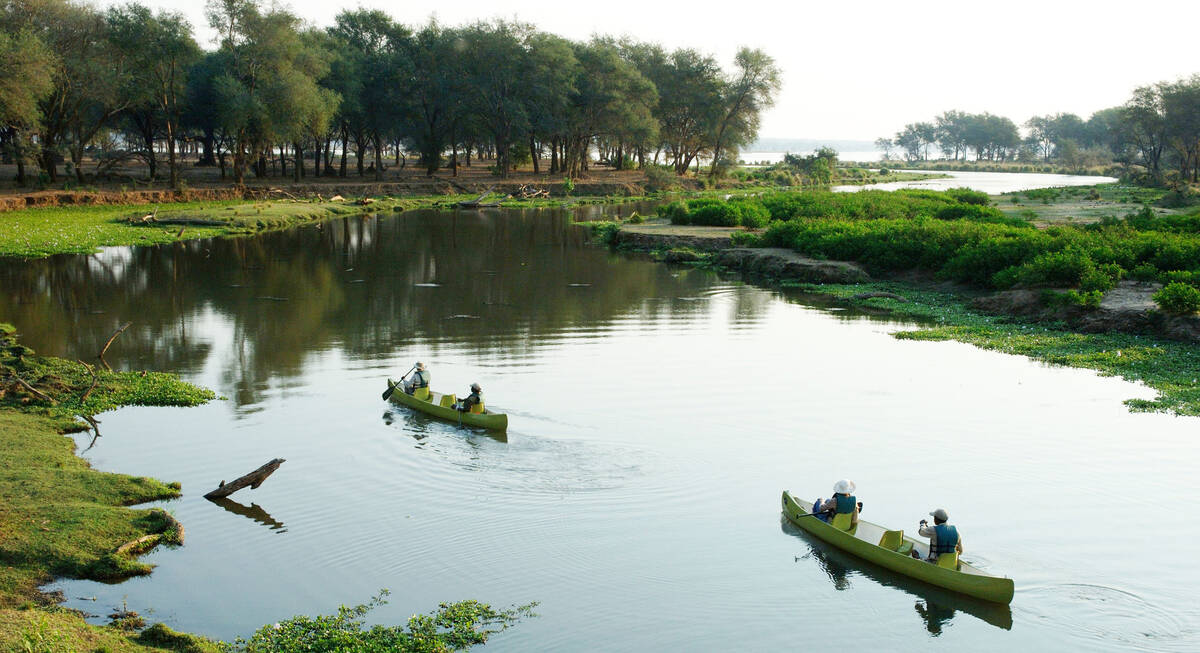
Crawshay's Zebra Safari
10 days • 4 locations
LUSAKA AIRPORT TO LUSAKA AIRPORT
This superb safari combines two of Zambia’s best national parks, the South Luangwa and the Lower Zambezi. The camps are small and high quality with excellent safari guides.
US$10,460 - US$13,820 per person
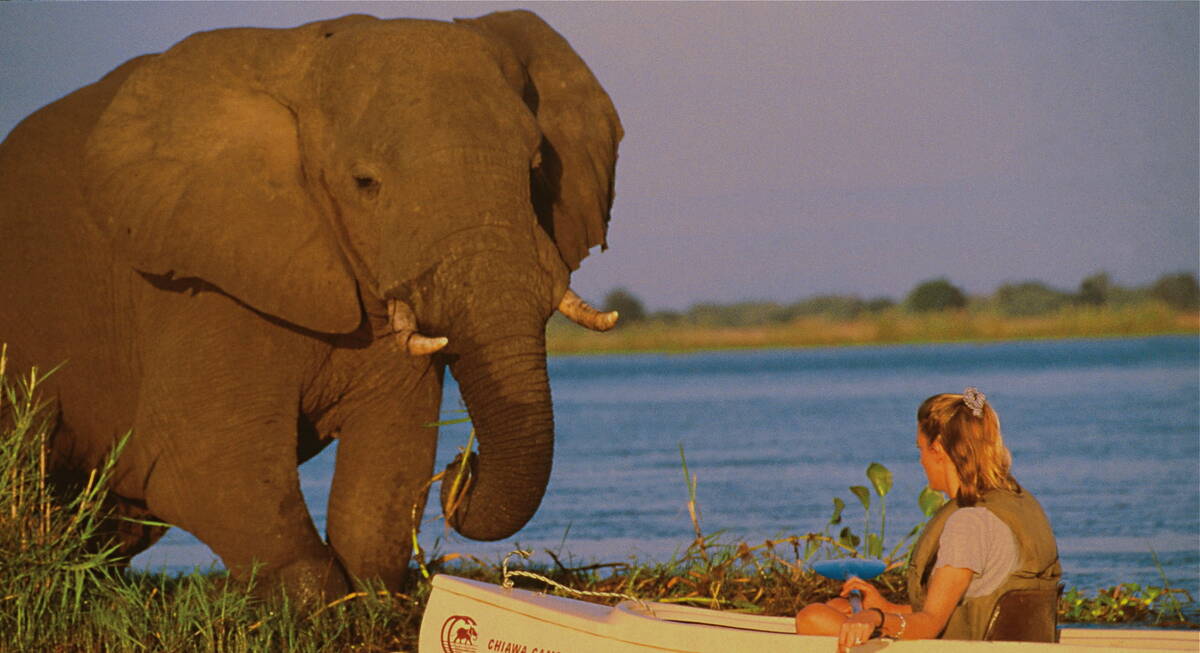
Slender Mongoose Safari
5 days • 2 locations
LUSAKA AIRPORT TO LUSAKA AIRPORT
A detailed exploration of Lower Zambezi from two top-notch sister camps, each in a prime location in the national park. Expect a high level of care, first-class guiding and superb wildlife.
US$6,580 - US$8,400 per person
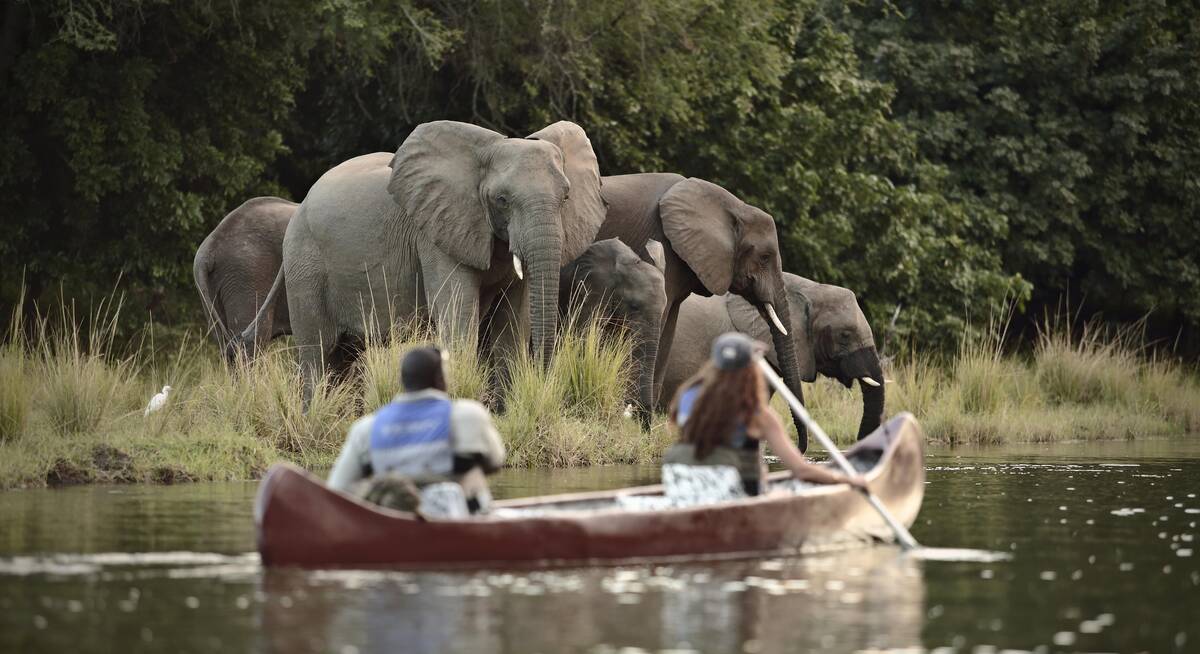
Duiker Safari
10 days • 3 locations
LUSAKA AIRPORT TO LUSAKA AIRPORT
Three luxurious bushcamps in stunning riverside locations, split between the South Luangwa and Lower Zambezi national parks, offer a wide variety of expert-guided safari activities in stunning game-rich environments.
US$10,960 - US$14,470 per person
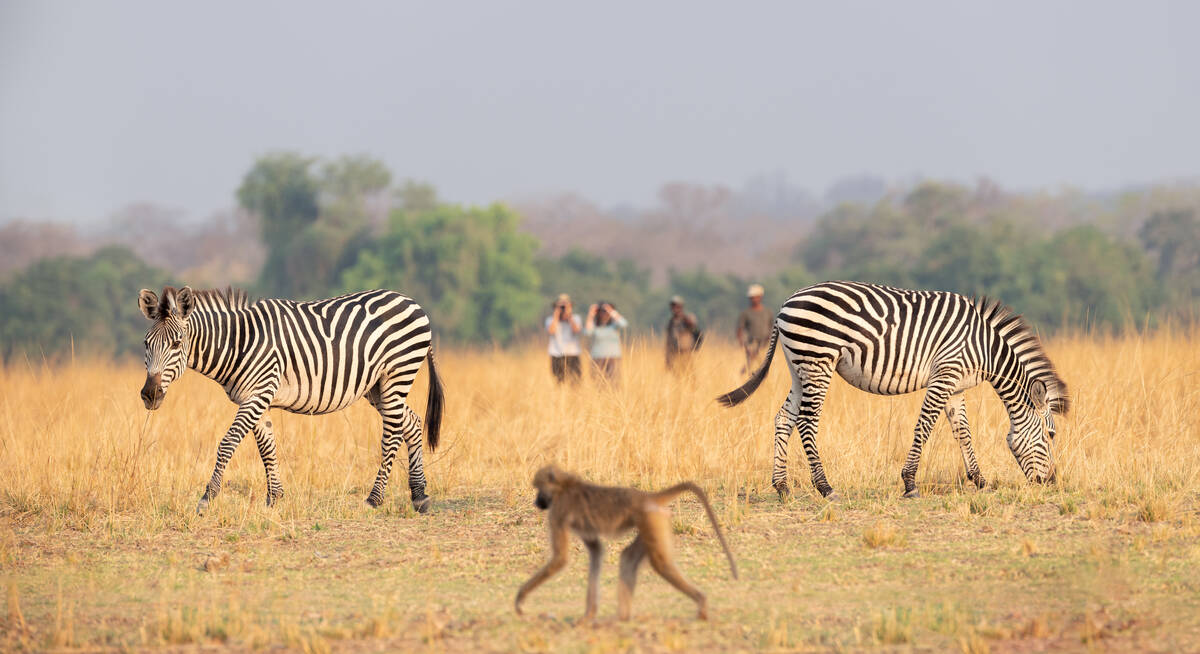
Vervet Monkey Safari
7 days • 2 locations
LUSAKA AIRPORT TO LUSAKA AIRPORT
Explore the world-class wildlife of Zambia’s South Luangwa and Lower Zambezi national parks in considerable luxury, guided by experts from two sister camps renowned for their excellent level of care.
US$8,780 - US$10,990 per person
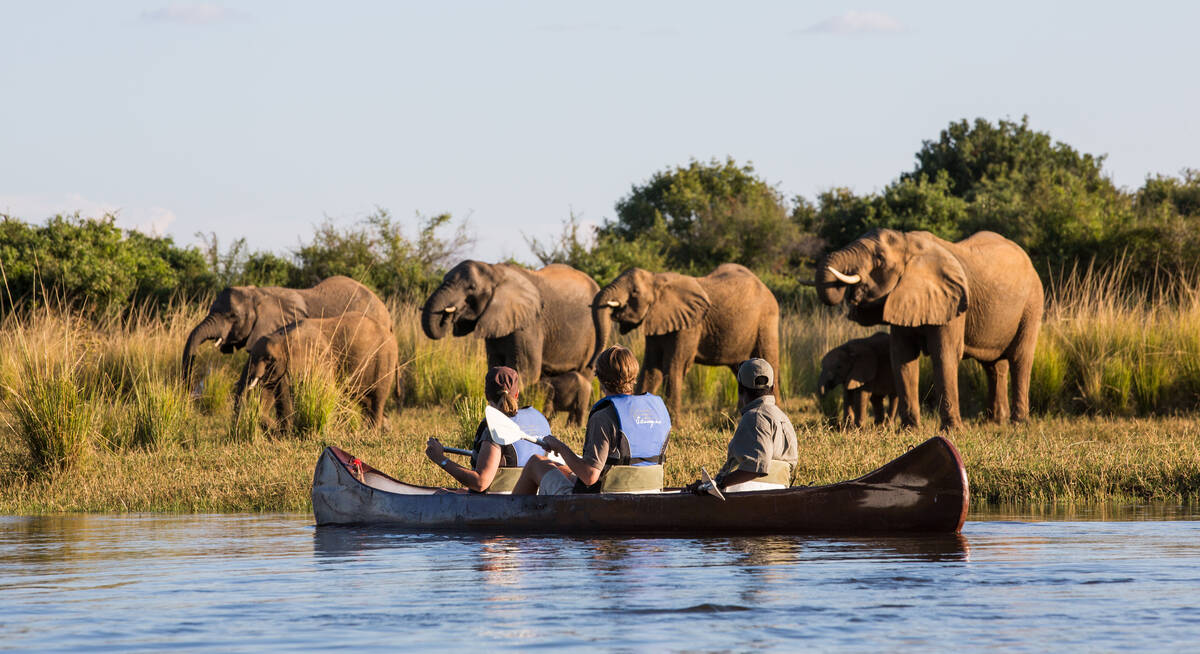
Greater Bushbaby Safari
8 days • 2 locations
LUSAKA AIRPORT TO LUSAKA AIRPORT
The perfect safari for a family or group of friends during which to create everlasting memories. Visit Zambia’s two most productive wildlife parks staying in four-bedroom houses, designed in a unique and fun way.
US$10,660 - US$13,240 per person
Our travellers' most recent reviews of safaris in Lower Zambezi National Park
Click below to browse all 365 reviews from our travellers’ safaris in the Lower Zambezi National Park. All are reproduced in full and are unedited.
Arrived 31 Oct 2024, 11 nights
"My Oct 2024 trip"
Overall rating: Excellent
Arrived 29 Oct 2024, 15 nights
"My Oct 2024 trip"
Overall rating: Excellent
Arrived 15 Oct 2024, 14 nights
"My Oct 2024 trip"
Overall rating: Excellent
Arrived 9 Oct 2024, 13 nights
"My Oct 2024 trip"
Overall rating: Excellent
Arrived 26 Sep 2024, 14 nights
"My Sep 2024 trip"
Overall rating: Excellent
Arrived 11 Sep 2024, 38 nights
"Our Sep/Oct 2024 trip"
Overall rating: Excellent
Arrived 10 Sep 2024, 23 nights
"Botswana & Zambia Sept 2024"
Overall rating: Excellent
Arrived 6 Sep 2024, 14 nights
"My Sep 2024 trip to Zambia"
Overall rating: Good
Arrived 4 Sep 2024, 14 nights
"My Sep 2024 trip"
Overall rating: Excellent
Arrived 29 Aug 2024, 11 nights
"My Aug 2024 trip"
Overall rating: Excellent
Where to stay in Lower Zambezi National Park
At Expert Africa, we concentrate on the safari lodges that are within, or beside, the Lower Zambezi National Park itself, as we believe that these offer the best game and safari experience. All are widely spaced in natural bush along the river, with wildlife regularly roaming through camp - and you’ll see few, if any, other vehicles during a game drive.
Although the places to stay in the Lower Zambezi National Park differ in style, from sophisticated safari lodges to the simplest of bush camps, you can expect personal service that is up there with the best. Guiding is generally excellent, with all guides trained to the high standards set by the Lower Zambezi Conservation Trust.
Several of the camps in the valley are independently owned and run, and receive consistently high reports from our travellers. There are also a couple of safari houses, which are great options for small groups or families travelling together.
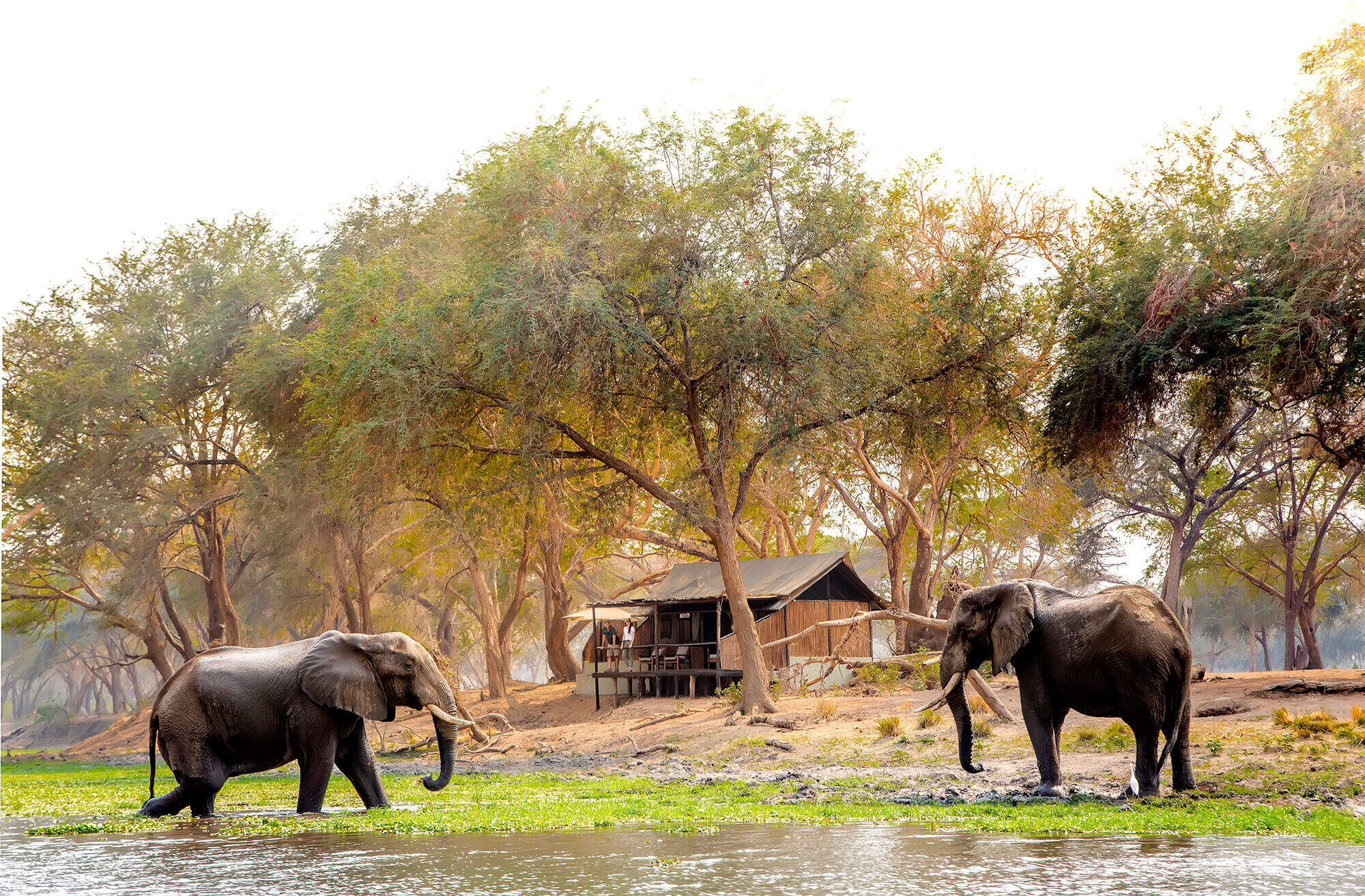
Old Mondoro Bushcamp
For an intimate safari in the Lower Zambezi, with superb guiding, Old Mondoro is up there with the best.
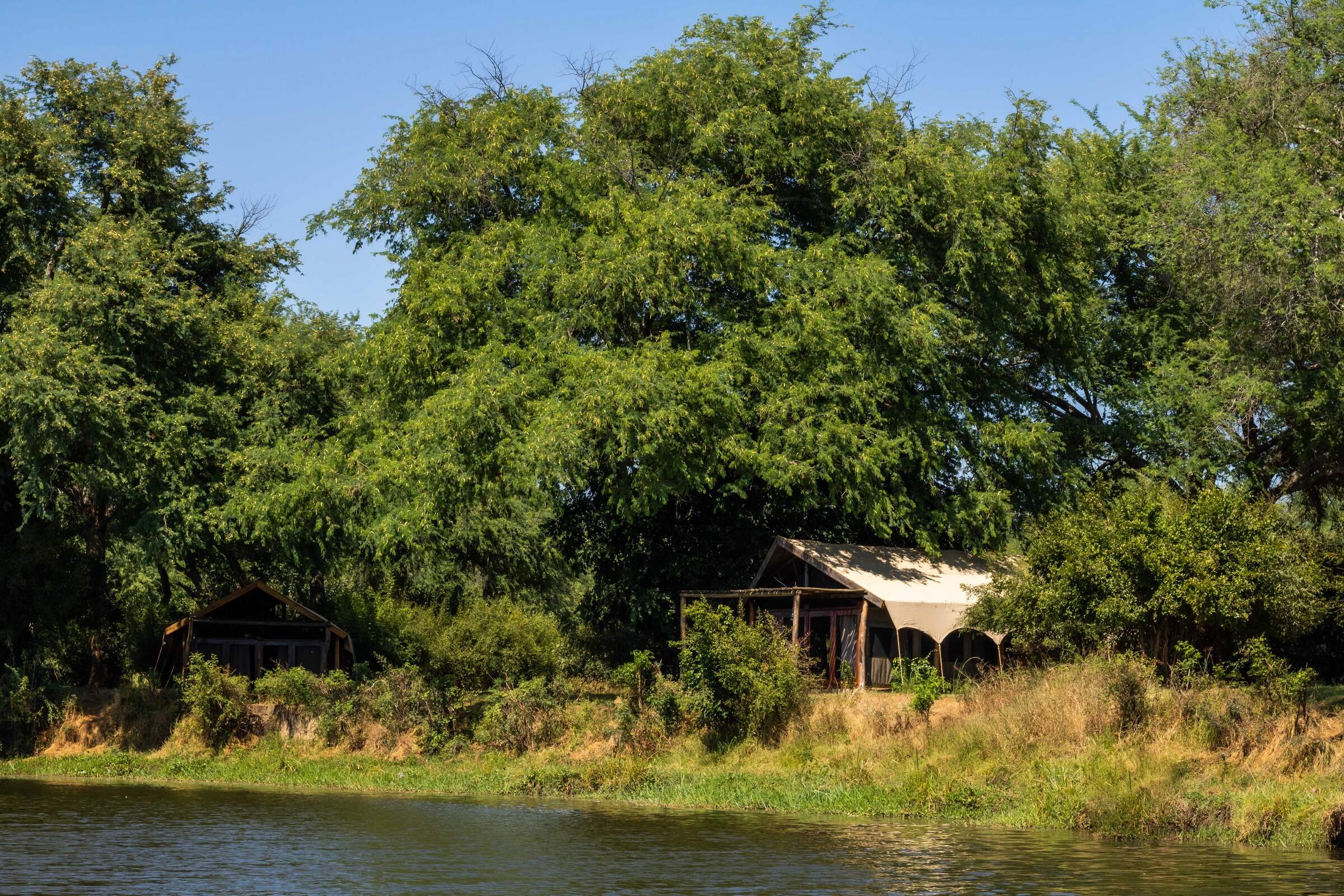
Chongwe River Camp
A blend of the stylish and traditional in a most picturesque site in the Zambezi Valley, Chongwe River Camp offers an excellent safari experience and real value for money.
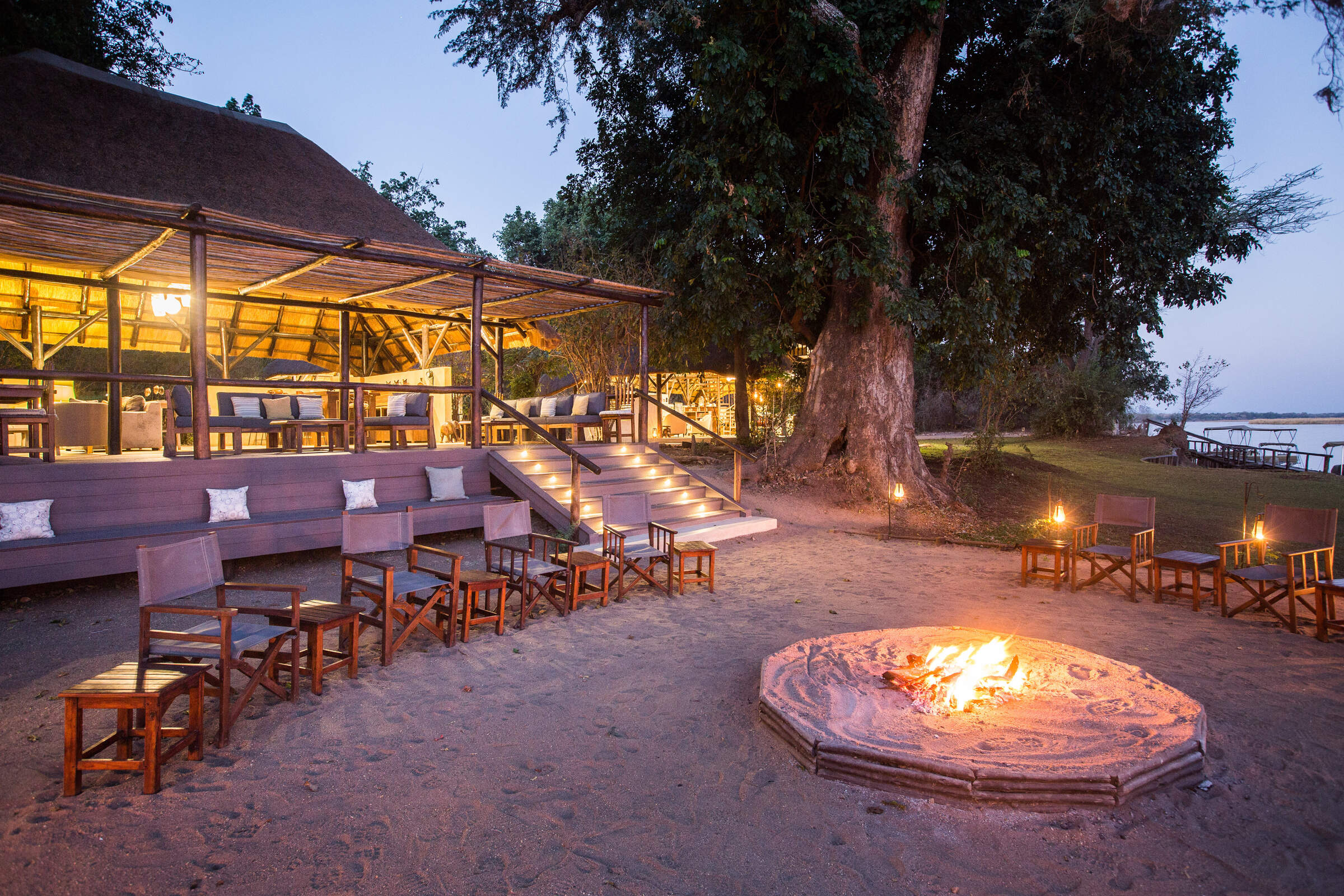
Chiawa Camp
One of Zambia's top safari camps, Chiawa is family owned and run, offering superb service and a flexible approach from a location well inside the Lower Zambezi National Park.
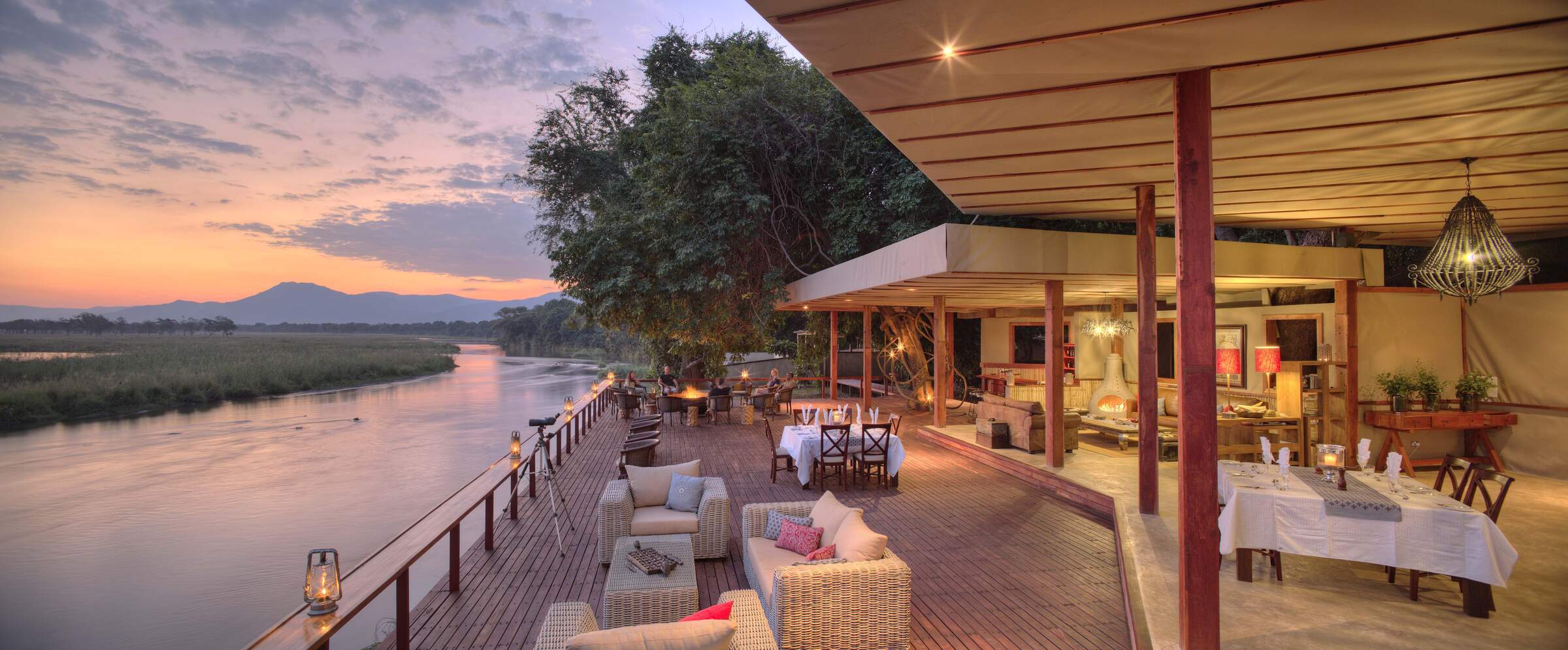
Sausage Tree Camp
Sausage Tree is a high-quality safari camp offering a luxurious stay and excellent personal service deep inside Zambia's Lower Zambezi National Park.
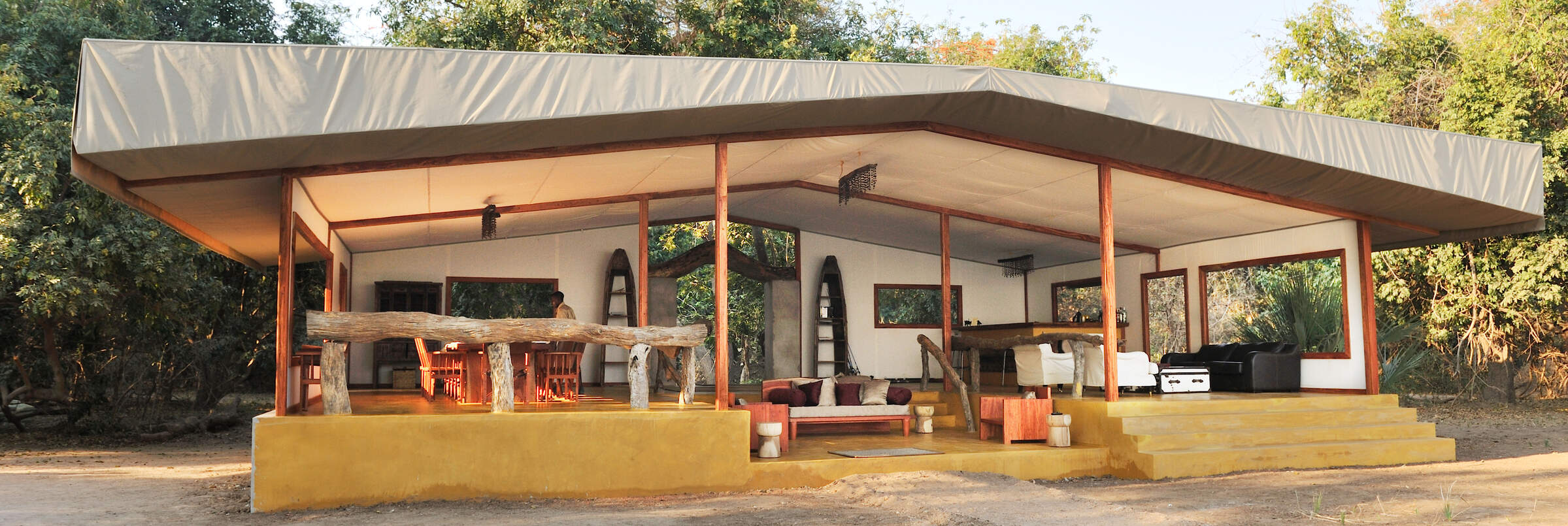
Potato Bush Camp
Potato Bush is located right in the heart of the Lower Zambezi National Park, with privately guided activities taking you on game drives, walks, boat trips and canoeing.
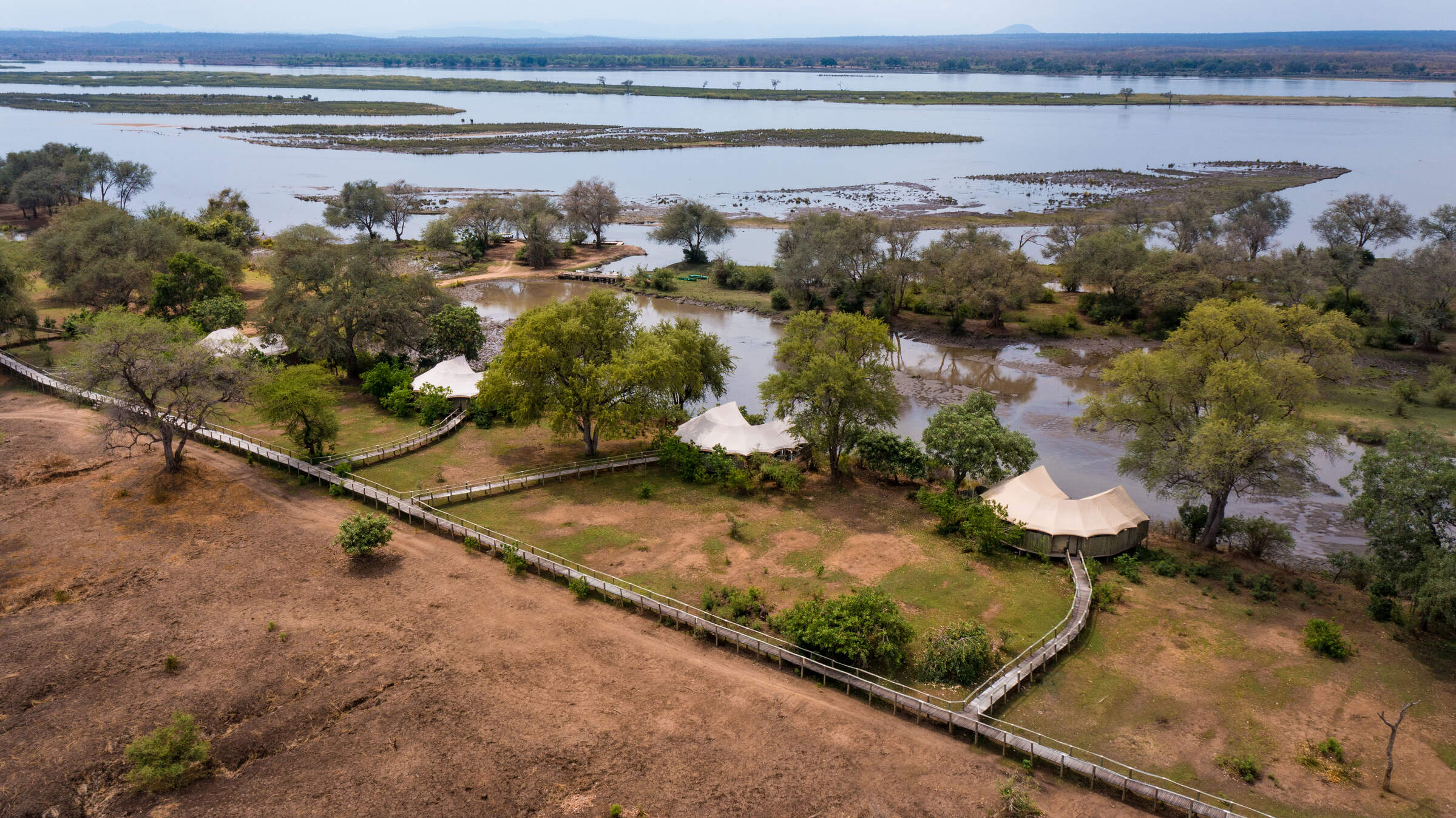
Anabezi Luxury Camp
Anabezi Luxury Tented Camp offers a high degree of understated luxury in a very lovely, quiet part of the Lower Zambezi with outstanding wildlife.
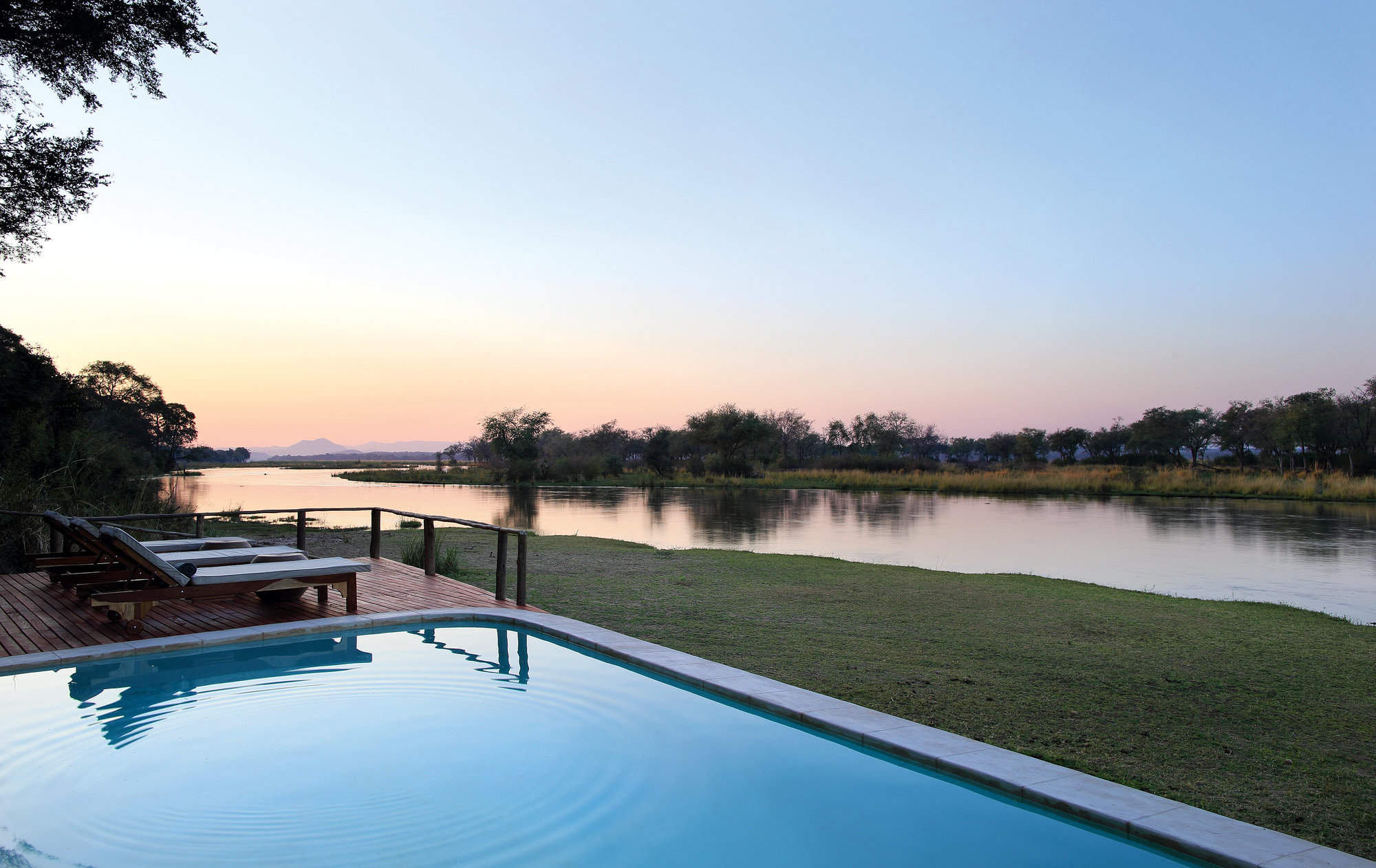
Amanzi
Opened in 2015, Amanzi is an intimate and rustic yet luxury camp in a very quiet area of the Lower Zambezi, with plenty of wildlife and good birding.
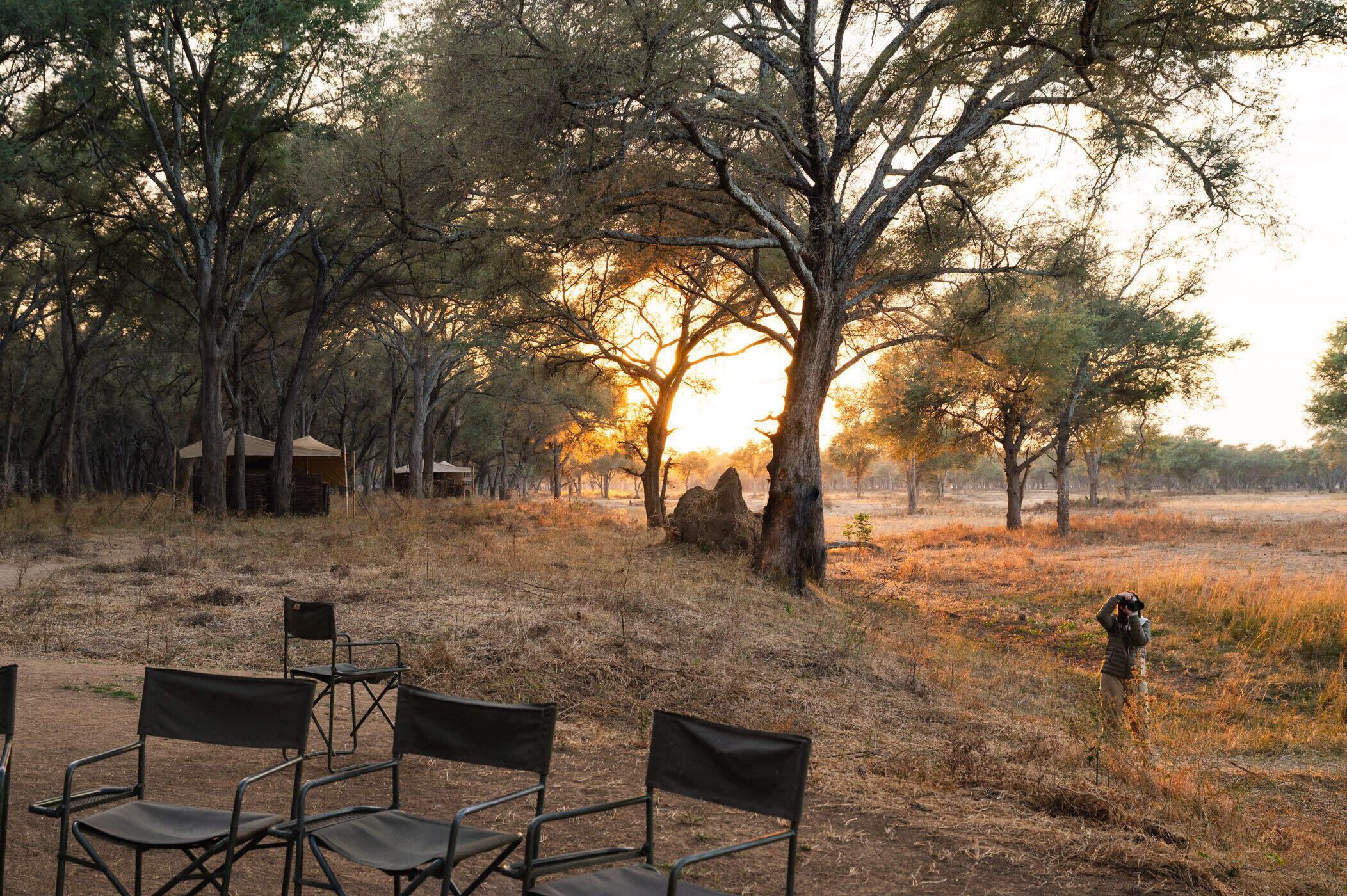
Kutali Camp
Kutali Camp offers the opportunity to experience the wilderness of Zambia’s Lower Zambezi National Park, in this simple tented camp located on Kulefu Island.
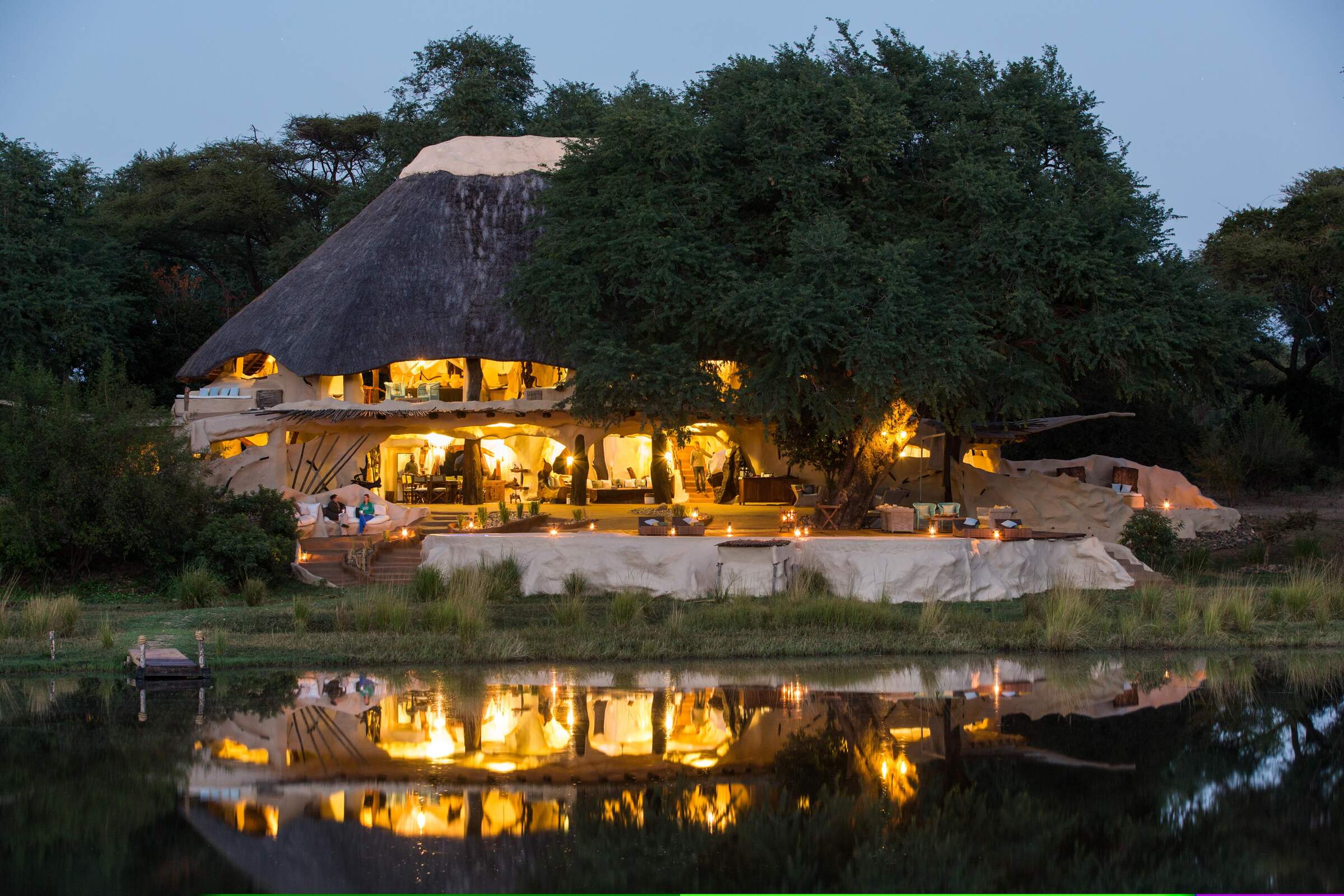
Chongwe River House
Chongwe River House is a stylish four-bedroom house designed for the exclusive use of families and small groups, affording the ultimate in flexibility on safari.
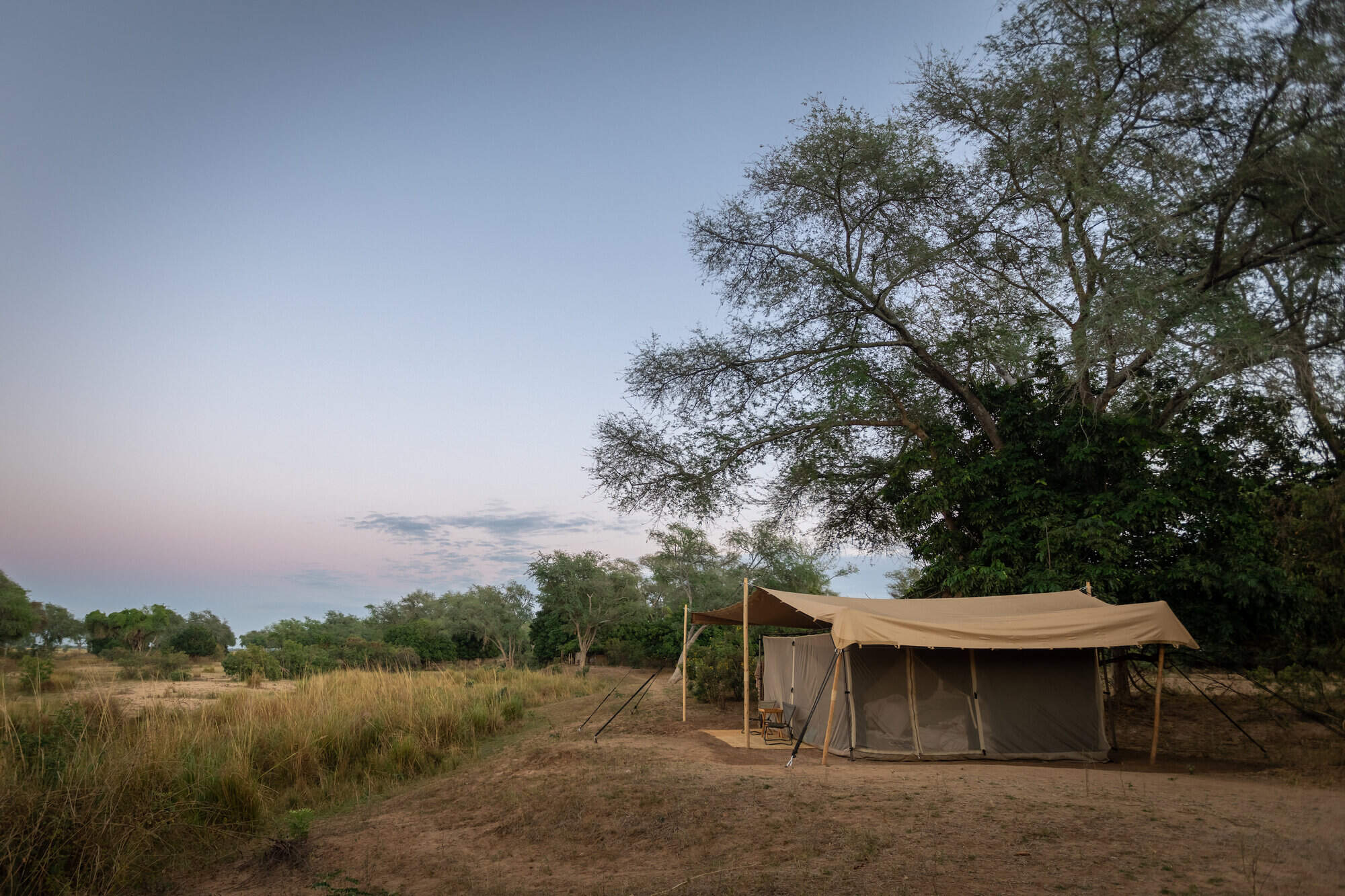
Chula Island Camp
Chula Island Camp offers the opportunity to experience the wilderness of Zambia’s Lower Zambezi National Park, in this simple fly-camp located in a natal mahogany grove on a small island on the Zambezi River.
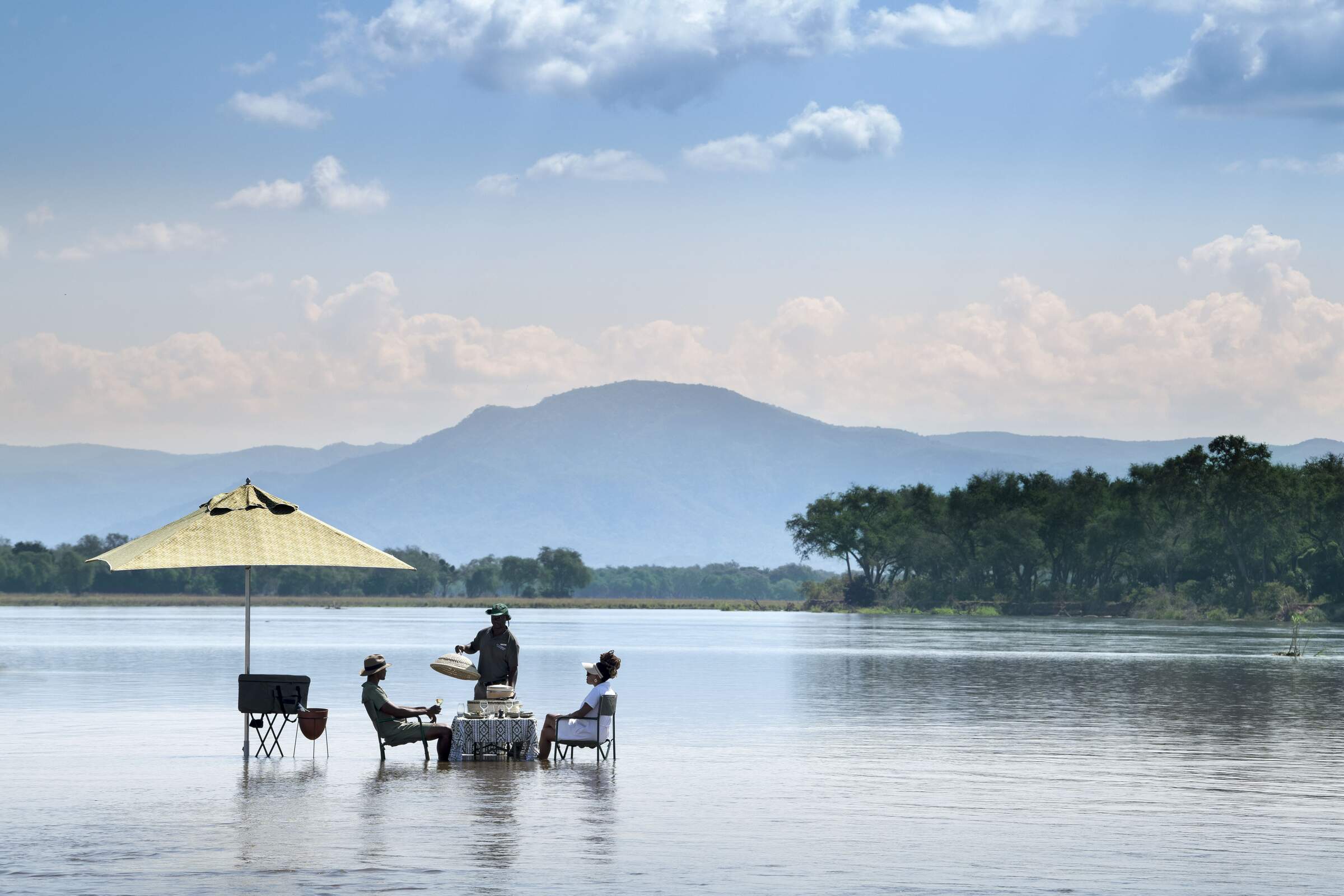
Lolebezi
A chic safari spot, luxurious Lolelbezi is the Lower Zambezi’s newest camp and offers a mix of walking, canoeing and game drives led by excellent guides.
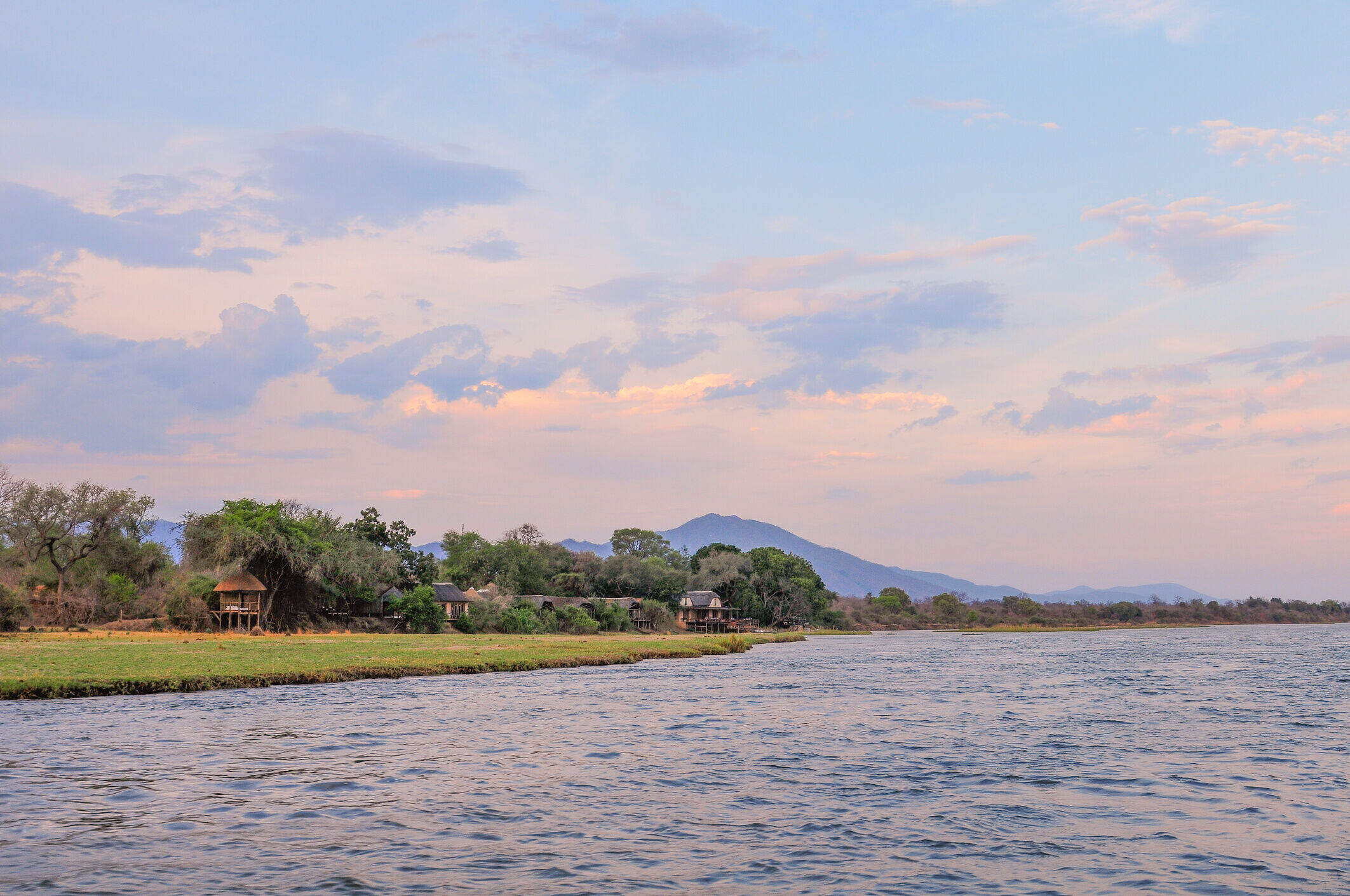
Royal Zambezi Lodge
This family-friendly lodge is located just on the outskirts of the Lower Zambezi National Park, in a great location overlooking the river.
Wildlife of the Lower Zambezi
In our experience, the Lower Zambezi is an excellent park for a wildlife safari, its major predators being lion, leopard and spotted hyena.
The varied terrain, with many large trees, seems to suit leopards, while large herds of buffalo attract large prides of lion. Wild dogs also occur, and generally den in or near the park, although sightings tend to be sporadic.
Like buffalo, elephant are common, moving freely between Zimbabwe and Zambia, and often grazing on the islands in the middle of the river. Impala dominate the antelope species, but there are also good populations of kudu, eland, zebra, wildebeest, waterbuck, bushbuck and the odd duiker or grysbok.
Giraffe, however, are completely absent (there’s no record of them ever having lived here) as are cheetah and black rhino – the latter due to poaching. In the river, crocodile and hippo are a constant presence, but look out too for the large water monitor lizard, which occurs frequently here.
Click on a species below for more information on the top locations in the Lower Zambezi for wildlife sightings.
Visit our Wildlife Surveys page to find out more about how we collect the data, why we think this is important, and how you can get involved on your safari.

100% success

100% success

96% success

95% success

86% success

78% success

71% success

39% success

14% success

7% success

5% success

0% success

0% success
When to go to Lower Zambezi National Park
Most of the camps in the Lower Zambezi open only in the dry season, typically between April and November. Outside of these months, the “roads” in the park – largely only dirt tracks – become impassable to vehicles, and access is only by boat.
Within these parameters, the best time to visit the Lower Zambezi will depend on your interests. For top wildlife sightings, the later in the season, the better – from around mid August to mid October – which is also the busiest time of the year, and the most expensive.
May and June tend to be quieter, and slightly less costly, but still with good wildlife, while the least expensive months are at each end of the season.
Fishing is generally good throughout the season, but for birders, either early or late in the season is a better bet. Known as the “green season”, this is when migrant birds arrive from Europe and North Africa, and activity is at its peak.
Jan
Feb
Mar
Apr
May
Jun
Jul
Aug
Sep
Oct
Nov
Dec
Lower Zambezi National Park in January
At the peak of Lower Zambezi's green season, expect heavy rainfall for a few hours on many days with sunny spells in between. Temperatures remain high, reaching over 30°C/86°F with high humidity. The landscape is lush and green, but wildlife disperses, making game viewing challenging. The thick vegetation limits walking safaris. However, this is an excellent time for birdwatching as migrant species boost the park's bird count.
Many camps close during this period, but those remaining open offer their lowest rates. The Zambezi River swells, creating spectacular scenes along its banks. Boat safaris can be particularly rewarding, offering chances to spot hippos, crocodiles, and various waterbirds. Despite the challenges, the park's beauty during this wet season is undeniable, with vibrant colours and dramatic skies.
- Peak of rainy season, hot and humid
- Most camps closed, limited accessibility
- Lush green landscape, great for photography
- Dispersed wildlife, challenging game viewing
- Lowest visitor numbers, cheapest rates
Our view
This is not a great time to visit
Weather in January
Lower Zambezi National Park in February
February remains in the heart of the green season in Lower Zambezi National Park. Dramatic thunderstorms deliver a few hours of rain most days, interspersed with clear sunny skies.
The abundance of water disperses game, making wildlife viewing more challenging. However, the swollen Zambezi River allows for unique boat safaris, offering close encounters with hippos and crocodiles. Birdwatching is excellent, with many migratory species present. The lush vegetation creates a picturesque backdrop for photography.
While game drives may be less productive, canoeing trips can be particularly rewarding, allowing quiet approaches to wildlife along the riverbanks. The few camps that remain open charge their lowest rates, providing an opportunity for budget-conscious travellers to experience the park's wet season beauty.
- Continued rainy season, hot and humid
- Many camps still closed, limited options
- Green landscape, photographic opportunities
- Difficult game viewing due to thick vegetation
- Low visitor numbers, affordable rates
Our view
This is not a great time to visit
Weather in February
Lower Zambezi National Park in March
March marks the last month of the green season in the Lower Zambezi. Heavy downpours still occur most days, with water levels at their highest. Temperatures reach over 30°C/86°F, with high humidity.
While many camps remain closed, those few remaining open offer unique wet season experiences. Boat safaris are particularly exciting, with the swollen Zambezi River providing extended exploration areas. Wildlife sightings may be sporadic, but many animals are raising young, offering heartwarming scenes.
Predators like lions and wild dogs are active, taking advantage of vulnerable prey. The lush, green landscape and clear air create stunning photographic opportunities. Birdwatching remains excellent as thousands of birds prepare for their winter migration. Despite challenges, March offers a different perspective of the park's ecosystem.
- Late rainy season, occasional showers
- A few camps begin to reopen
- Landscape still green, good for photography
- Improved wildlife viewing as vegetation thins
- Few visitors; rates for camps low
Our view
This is not a great time to visit
Weather in March
Lower Zambezi National Park in April
As the rains transition to lighter, sporadic showers, April marks a period of change in Lower Zambezi National Park. The landscape remains exceptionally green and lush. While larger wildlife viewing may be sparse, this is an excellent time for birding enthusiasts.
The Zambezi River is at its highest, creating spectacular scenes along its banks. Boat safaris offer unique perspectives of the flooded landscape. As camps slowly start to reopen, visitors can enjoy lower off-season rates. The park's famous canoe safaris become increasingly viable as water levels stabilise.
Night game drives can be particularly rewarding, offering chances to spot nocturnal animals like civets and genets. April's transitional nature provides a blend of wet and dry season experiences.
- End of rainy season, drier conditions
- More camps open, better accessibility
- Landscape transitioning, good for photos
- Improved game viewing, animals more visible
- Visitor numbers rise, rates remain low
Our view
This is not a great time to visit
Weather in April
Lower Zambezi National Park in May
May typically marks the start of the dry season in the Lower Zambezi. While there's a chance of an odd shower, most days are clear and sunny. As winter approaches, daytime temperatures reach highs of around 26°C/79°F. The landscape begins to dry out, improving access throughout the park.
Most camps reopen, offering a wider range of accommodation options. Game viewing improves significantly as animals start to congregate around permanent water sources. Boat safaris on the Zambezi River become increasingly popular, offering close encounters with hippos, crocodiles, and various bird species.
Walking safaris resume, providing intimate wildlife experiences. May's pleasant weather and improved game viewing make it an excellent time to visit, with some camps still offering shoulder season rates.
- Start of dry season, cooler temperatures
- Most camps open, full range of activities
- Landscape drying, clearer wildlife sightings
- Excellent time for walking safaris
- Visitor numbers increase, rates go up
Our view
A good time to visit, with pros & cons
Weather in May
Lower Zambezi National Park in June
The Lower Zambezi sees virtually no rainfall in June, with sunny days predominating. Humidity drops dramatically, and temperatures range from 10°C/50°F at night to 25°C/77°F during the day. The landscape remains relatively lush, but vegetation starts to thin, significantly improving game viewing.
All camps in the park are open, some offering shoulder-season rates. The Zambezi River's water levels begin to recede, concentrating wildlife along its banks. This is an excellent time for canoe safaris, offering unique perspectives of the park's ecosystem.
Game drives become increasingly productive, with higher chances of spotting predators like lions and leopards. June's pleasant temperatures and improved wildlife sightings make it a popular month for visitors.
- Dry season, cool days and cold nights
- All camps open, peak activity options
- Improved wildlife viewing around water sources
- Prime time for walking safaris and game drives
- High season begins, increased rates
Our view
A very good time to visit
Weather in June
Lower Zambezi National Park in July
As the dry season continues in Lower Zambezi National Park, vegetation thins and water becomes scarcer. Wildlife is starting to cluster around major water sources, particularly the Zambezi River, leading to excellent game viewing opportunities.
July marks the heart of winter, with daytime temperatures in the 20s Celsius / 70s Fahrenheit but dropping to single digits at night. Early morning and late evening game drives can be very chilly, with camps often providing blankets and hot water bottles.
This is prime time for walking safaris, offering exciting wildlife encounters. Canoe trips on the Zambezi River are particularly rewarding, with high chances of spotting elephants coming to drink. Visitor numbers increase, and properties charge peak season rates.
- Peak dry season, clear skies
- Excellent game viewing, especially near river
- Popular time for canoe and boat safaris
- Night drives offer nocturnal wildlife sightings
- Peak season, highest rates and visitor numbers
Our view
A very good time to visit
Weather in July
Lower Zambezi National Park in August
August in the Lower Zambezi offers excellent game viewing as wildlife congregates around remaining water sources. With virtually no chance of rain, sunny days are almost guaranteed. Temperatures can drop below 5°C/41°F at night but climb to the 20s Celsius / 70s Fahrenheit during the day.
The thinned vegetation provides clear views of animals, making this one of the best months for photography. Boat safaris on the Zambezi River offer close encounters with hippos, crocodiles, and elephants. Tiger fishing is at its peak, attracting anglers from around the world.
Walking safaris provide thrilling up-close wildlife experiences. This is one of the most popular months to visit, with camps charging their highest rates and often fully booked well in advance.
- Very dry, animals concentrate near water
- Outstanding wildlife viewing opportunities
- Ideal for photography and walking safaris
- Zambezi River cruises highly recommended
- Peak season continues, advance booking needed
Our view
Fantastic: the very best time to visit
Weather in August
Lower Zambezi National Park in September
September is one of the best times to visit Lower Zambezi National Park for wildlife enthusiasts. Rain is almost unheard of, humidity is low, and daytime temperatures climb to the low 30s Celsius / high 80s Fahrenheit.
Water is scarce, concentrating wildlife around the Zambezi River and remaining water holes. Game viewing is at its peak, with high chances of seeing predator-prey interactions. Elephant herds are frequently spotted crossing the river.
Canoe safaris offer thrilling close encounters with wildlife. Night game drives provide opportunities to spot nocturnal animals like leopards and genets. Birdwatching remains excellent, with many species nesting. However, this popularity comes at a price: camps charge their highest rates and are often fully booked far in advance.
- Hot days, warm nights, very dry
- Excellent month for wildlife viewing
- Zambezi River at its lowest, great for canoeing
- Increased elephant sightings near water
- High season, camps can be fully booked
Our view
Fantastic: the very best time to visit
Weather in September
Lower Zambezi National Park in October
October marks the peak of the dry season in the Lower Zambezi. Away from the Zambezi, the national park is brown and barren, with little ground-level vegetation. Temperatures can be uncomfortably hot, often exceeding 40°C/104°F during the day.
Despite the heat, this is considered the best month for game viewing. The scarcity of water forces animals to congregate around the main river, leading to frequent wildlife sightings and predator-prey interactions.
Boat safaris offer relief from the heat and excellent opportunities to observe elephants, hippos, and crocodiles. Walking safaris may be challenging due to the heat but provide thrilling wildlife encounters. October is prime time for spotting large predators like lions and leopards.
- Hottest month, animals congregate at river
- Peak time for wildlife viewing and photography
- Excellent for boat safaris and fishing
- Chance to see elephants crossing the river
- End of high season, some rate reductions
Our view
A very good time to visit
Weather in October
Lower Zambezi National Park in November
November typically marks the end of the dry season in the Lower Zambezi. While the timing of rains is uncertain, temperatures remain high and humidity builds.
Early November may still offer excellent game viewing, with animals concentrated around water sources. As the month progresses, the arrival of rains leads to rapid vegetation growth and wildlife dispersal. This transition period can be fascinating to witness. The initial rains bring relief to the parched landscape, with new growth attracting grazing animals.
Birdwatching improves as migratory species arrive in the valley. While some remote camps close, those that remain open significantly drop their rates. November offers a unique opportunity to experience both dry and wet season aspects of the park.
- Start of rainy season, occasional showers
- Wildlife disperses as water becomes available
- Good birding as migratory species arrive
- Lush landscapes return, photography improves
- Shoulder season, lower rates and fewer visitors
Our view
A good time to visit, with pros & cons
Weather in November
Lower Zambezi National Park in December
December marks the start of the green season in the Lower Zambezi National Park. Heavy thunderstorms occur most days, interspersed with sunny spells. Temperatures reach over 30°C/86°F with high humidity.
The rainfall brings abundant water to the landscape, encouraging lush vegetation growth. While game viewing becomes more challenging due to the thick bush and dispersed wildlife, this is an excellent time for birdwatching. Migratory birds arrive, boosting the species count. Boat safaris on the swollen Zambezi River offer unique perspectives of the flooded landscape.
Many camps close for the season, but those remaining open charge their lowest rates. Despite the challenges, December offers a green and vibrant aspect of the park, with dramatic skies and fewer visitors.
- Rainy season in full swing, hot and humid
- Some camps close, limited accessibility
- Newborn animals, great for bird watching
- Challenging game viewing, but lush scenery
- Low season, cheapest rates, fewer tourists
Our view
This is not a great time to visit
Weather in December
Lower Zambezi National Park: In detail
Guide to the Lower Zambezi National Park
The Lower Zambezi valley is a huge rift in the earth's crust, through which a mighty river flows. Over millennia, mineral-rich volcanic soils deposited by the Zambezi have nurtured lush vegetation, while old meanders and oxbow lakes add to the attraction for wildlife.
There are national parks on both sides of the river – Mana Pools National Park on the Zimbabwean bank, and the Lower Zambezi National Park on the Zambian side.
The landscape is beautiful: tall leadwoods, ebonies, acacias and figs stand on a carpet of rich grassland. But the main attraction is the area's game, which congregates near the river during the dry season.
Safaris to Lower Zambezi National Park
Flights can be organised from Lusaka, Livingstone or South Luangwa's Mfuwe Airport, making a Lower Zambezi safari easy to combine with time in the South Luangwa National Park or a trip to Victoria Falls. On arrival you will be met by someone from your safari lodge, and transferred by 4WD, taking in any game that you see along the way. Back at the camp, you will be welcomed by the team with some time to settle in, before heading out on an activity such as a safari walk or drive.
Activities on a Lower Zambezi safari
Game drives in open-topped 4WD vehicles are a regular fixture in all camps, but most also offer the option of a walking safari with a qualified guide and armed ranger.
On the water, there are boat trips to explore the Zambezi, keeping an eye out for hippos, crocodile and an impressive array of birds. The more intrepid might prefer to take to the waters in a canoe, while anglers won’t want to miss the opportunity to seek out the mighty tigerfish (though note that all fishing here is on a catch-and-release basis).
Vegetation of Lower Zambezi National Park
Here the vegetation is very different: rich soils nurture tall, strong trees typical of riverine areas, including ebonies, leadwoods and fig trees. Winterthorn woodlands - where the apple-ring fruits are so popular with hungry elephants - seem to stretch endlessly along the river. The beauty of these areas is that bush growth under the trees is usually sparse or even absent; this allows unobscured views of game, and makes a great environment for walking safaris.
Birdlife of the Lower Zambezi National Park
Map of Lower Zambezi National Park
Our maps of the Lower Zambezi show the region in several different ways – from a simplified reference map to the topographical detail of the terrain mapping. To see the lie of the escarpment that forms a natural barrier to the north of the national park, zoom in on the terrain map; this is the limit of the Lower Zambezi National Park.
These maps also show all the safari camps and lodges that we offer beside or within the Lower Zambezi National Park. To read more about them, click on the orange markers, and follow the links in the bubbles to read more details and reviews, or for a closer view.
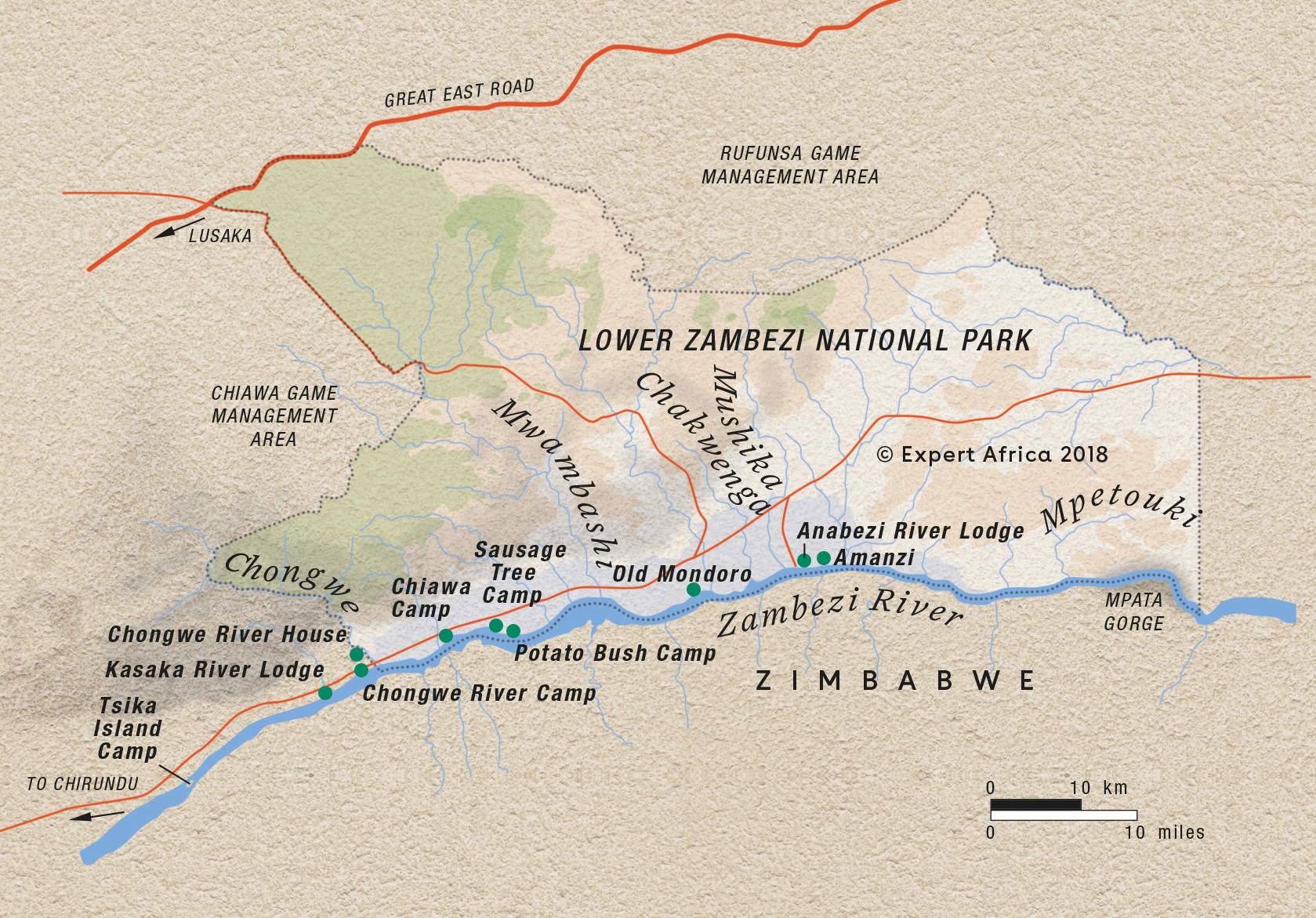
Ideas for safari holidays in Lower Zambezi National Park
Visitors to the Lower Zambezi National Park, with its location on the wide Zambezi River, can choose from an exceptional range of activities; there’s no such thing as a “best safari” in the Lower Zambezi!
Most safari lodges offer two activities a day, one in the early morning, the second in late afternoon – with plenty of time for a leisurely lunch and a siesta between the two.
Game drives in open-topped 4WD vehicles feature in all camps, but most also offer the option of a walking safari with a qualified guide and armed ranger. On the water, there are boat trips to explore the Zambezi, keeping an eye out for hippos, crocodile and an impressive array of birds.
The more intrepid might prefer to take to the waters in a canoe, while anglers won’t want to miss the challenge of the mighty tigerfish (though note that all fishing is on a catch-and-release basis).

Crawshay's Zebra Safari
10 days • 4 locations
LUSAKA AIRPORT TO LUSAKA AIRPORT
This superb safari combines two of Zambia’s best national parks, the South Luangwa and the Lower Zambezi. The camps are small and high quality with excellent safari guides.
US$10,460 - US$13,820 per person

Slender Mongoose Safari
5 days • 2 locations
LUSAKA AIRPORT TO LUSAKA AIRPORT
A detailed exploration of Lower Zambezi from two top-notch sister camps, each in a prime location in the national park. Expect a high level of care, first-class guiding and superb wildlife.
US$6,580 - US$8,400 per person

Duiker Safari
10 days • 3 locations
LUSAKA AIRPORT TO LUSAKA AIRPORT
Three luxurious bushcamps in stunning riverside locations, split between the South Luangwa and Lower Zambezi national parks, offer a wide variety of expert-guided safari activities in stunning game-rich environments.
US$10,960 - US$14,470 per person

Vervet Monkey Safari
7 days • 2 locations
LUSAKA AIRPORT TO LUSAKA AIRPORT
Explore the world-class wildlife of Zambia’s South Luangwa and Lower Zambezi national parks in considerable luxury, guided by experts from two sister camps renowned for their excellent level of care.
US$8,780 - US$10,990 per person

Greater Bushbaby Safari
8 days • 2 locations
LUSAKA AIRPORT TO LUSAKA AIRPORT
The perfect safari for a family or group of friends during which to create everlasting memories. Visit Zambia’s two most productive wildlife parks staying in four-bedroom houses, designed in a unique and fun way.
US$10,660 - US$13,240 per person
Our top 12 lodges and safari camps in Lower Zambezi National Park
Accommodation in the Lower Zambezi ranges from the traditional comfort of Chiawa and the modernised Sausage Tree, through the rather more corporate Anabezi, to the much more simple - but exceptionally rewarding - style of Old Mondoro.
Alongside these are a couple of fly-camps on islands in the Zambezi itself. Just outside the national park boundary, the independently run Chongwe Camp lies close to the family-friendly Chongwe House.
Within the park itself, Chiawa is the oldest camp in the valley and - like its sister "bushcamp" further upstream, Old Mondoro - is still in the hands of the family who founded it. Between the two lies a mix of the old and new: the long-established Sausage Tree, under new ownership in 2023, and the decidedly funky new kid on the block, Lolebezi.
Ask us for more details of what's where, and what's likely to suit you best.

Old Mondoro Bushcamp
For an intimate safari in the Lower Zambezi, with superb guiding, Old Mondoro is up there with the best.

Chongwe River Camp
A blend of the stylish and traditional in a most picturesque site in the Zambezi Valley, Chongwe River Camp offers an excellent safari experience and real value for money.

Chiawa Camp
One of Zambia's top safari camps, Chiawa is family owned and run, offering superb service and a flexible approach from a location well inside the Lower Zambezi National Park.

Sausage Tree Camp
Sausage Tree is a high-quality safari camp offering a luxurious stay and excellent personal service deep inside Zambia's Lower Zambezi National Park.

Anabezi Luxury Camp
Anabezi Luxury Tented Camp offers a high degree of understated luxury in a very lovely, quiet part of the Lower Zambezi with outstanding wildlife.

Potato Bush Camp
Potato Bush is located right in the heart of the Lower Zambezi National Park, with privately guided activities taking you on game drives, walks, boat trips and canoeing.

Amanzi
Opened in 2015, Amanzi is an intimate and rustic yet luxury camp in a very quiet area of the Lower Zambezi, with plenty of wildlife and good birding.

Kutali Camp
Kutali Camp offers the opportunity to experience the wilderness of Zambia’s Lower Zambezi National Park, in this simple tented camp located on Kulefu Island.

Chongwe River House
Chongwe River House is a stylish four-bedroom house designed for the exclusive use of families and small groups, affording the ultimate in flexibility on safari.

Chula Island Camp
Chula Island Camp offers the opportunity to experience the wilderness of Zambia’s Lower Zambezi National Park, in this simple fly-camp located in a natal mahogany grove on a small island on the Zambezi River.

Royal Zambezi Lodge
This family-friendly lodge is located just on the outskirts of the Lower Zambezi National Park, in a great location overlooking the river.

Looking for inspiration on where to travel next?
Visit our trip chooser to explore your options and find inspiration for your perfect African adventure
Inspire meFrequently Asked Questions
Lower Zambezi FAQs
With so many factors involved in planning a holiday to the Lower Zambezi, it’s easy to overlook something simple - yet fundamental. In this section we have tried to answer such questions, from where exactly is the Lower Zambezi, and how do you get there, to a family safari in the Lower Zambezi, and what to expect on a canoe safari.
Where exactly is the Lower Zambezi National Park?
To the north, the Lower Zambezi is bounded by a steep escarpment that acts as a natural barrier, enclosing a secluded yet surprisingly accessible wilderness covering some 4,092km2. Combining game drives and walking safaris with boat trips and canoe safaris, it is - along with the South Luangwa - one of Zambia's most popular national parks.
How do you get to the Lower Zambezi National Park?
On arrival you will be met by someone from your safari lodge, and transferred by 4WD, looking out for wildlife along the way. Once at the camp, you will have time to settle in, before heading out on an activity such as a safari walk or drive.
Although it is possible to drive into the valley, or even to drive part of the way and finish your journey by boat, arriving by air is the most efficient way to maximise your time within the park.
What’s the birdlife like in the Lower Zambezi?
Pied, giant, woodland, malachite and brown-hooded kingfishers are all common here, as are many wading birds, from squacco herons to yellow-billed storks. The river also draws darters and cormorants, while African fish eagles are often seen perching in trees overhead.
Uncommon residents include ospreys, Pels’ fishing owls, spoonbills and African skimmers. Carmine bee-eaters nest in great numbers in the sandbanks along the river, and southern ground hornbills are distinctive on the plains.
Is Lower Zambezi National Park good for a family safari holiday?
The best option for a family holiday in the Lower Zambezi would be Chongwe River House. Here, on the western edge of the park, flexibility is key – from meals and mealtimes to the day's choice of activities. With four huge en-suite bedrooms, the house is available to just one family or group of friends at a time.
The quirky design is an attraction in its own right, but more important is having your own private guide and vehicle. Thus, the choice of activity is up to you, and while children under the age of 12 may not take part in walking or canoe safaris, alternative activities can be arranged for them.
What can I expect from a canoe safari in the Lower Zambezi?
From most camps, you'll be paddling a two-person canoe along the main river, though in one or two areas, a narrower channel runs parallel to the main river, as with the Chifungulu Channel near Sausage Tree Camp.
Typically you’ll share the canoe with a qualified guide, but by agreement, a couple could be paddling together, with the guides paddling separate canoes with other guests.
Travelling with the current, there’s little effort required, leaving you to sit back and take in the scenery – and the wildlife. To observe elephant, buffalo, even leopard from water level is an extraordinary and thrilling experience.
It’s important, though, to understand the risks posed by crocodiles and – particularly – hippos. Should any approach too close, it’s crucial that you remain still and do exactly as you’re told; these guides are experienced in handling potential confrontations.
Other areas in Zambia
A safari in the Lower Zambezi National Park is complete in itself, but also combines well with Zambia's equally renowned South Luangwa National Park.
For some, the majesty of the Victoria Falls provides the icing on the cake. For others, it's the lure of walking safaris: look no further than the North Luangwa, where a handful of tiny camps specialise in exploring this little-visited park on foot.
Unrivalled for sheer scale is Kafue National Park, defined by the Kafue River that is an irresistible draw for wildlife, while for sheer remoteness, don't miss Liuwa Plain.
Big game aside, Zambia has some real surprises up its sleeve. Visit Kasanka National Park at the end of the year and you'll be rewarded with millions of fruit bats. Hike in total privacy at Mutinondo Wilderness. Or come face to face with an English stately home in the bush at Shiwa Ng'andu.
